Zendesk
Bi-directionally integrate Slack and Zendesk.
You’re viewing documentation for a previous version of Thena. For the most up-to-date content, visit: docs.thena.ai.
Overview
The Thena <> Zendesk integration seamlessly transforms customer messages on Slack into Zendesk tickets. With smart automation, customer inquiries on Slack are seamlessly routed to Zendesk, complete with auto-filled fields and customized forms. This powerful integration empowers Product Support Agents and Customer Success Managers to respond directly from Zendesk, ensuring replies are perfectly synced back to your Slack threads. Additionally, this integration provides visibility of ticket statuses across Slack, Zendesk, and the Thena web app.
Key features
| Feature | Supported by Thena |
|---|---|
| Ticket creation from Slack | ✔ |
| Bidirectional comments sync | ✔ |
| Multiple Zendesk instances & form management | ✔ |
| Comprehensive field retrieval | ✔ |
| Zendesk field permissions | ✔ |
| Zendesk field type mapping | ✔ |
| Standard and custom field sync | ✔ |
| Reopening tickets | ✔ |
Here's an overview of the key functionalities and how they enhance your user experience.
Methods of ticket creation from Slack
Refer to the below ways of creating a ticket from an incoming request on Slack.
- Using ticket emoji
Customers or vendors can initiate a ticket on Zendesk by simply reacting with the ticket emoticon (🎫) on any message. A form will appear for the user to fill in the required details and proceed with creating the ticket on Zendesk.
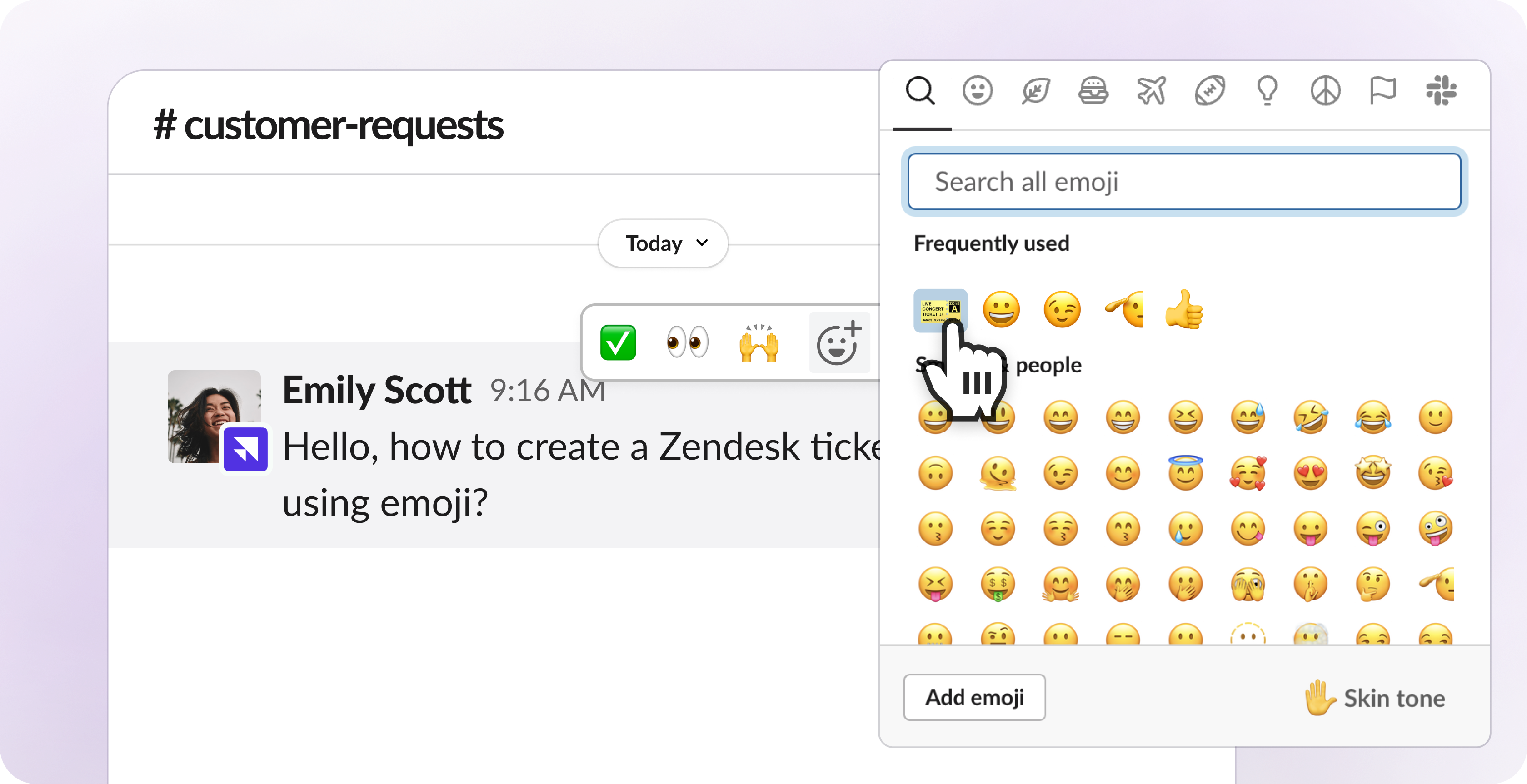
- Using Slack shortcut
As a Vendor, against the Slack message, click on the three dot menu and choose 'Create a Ticket Thena' Slack shortcut.
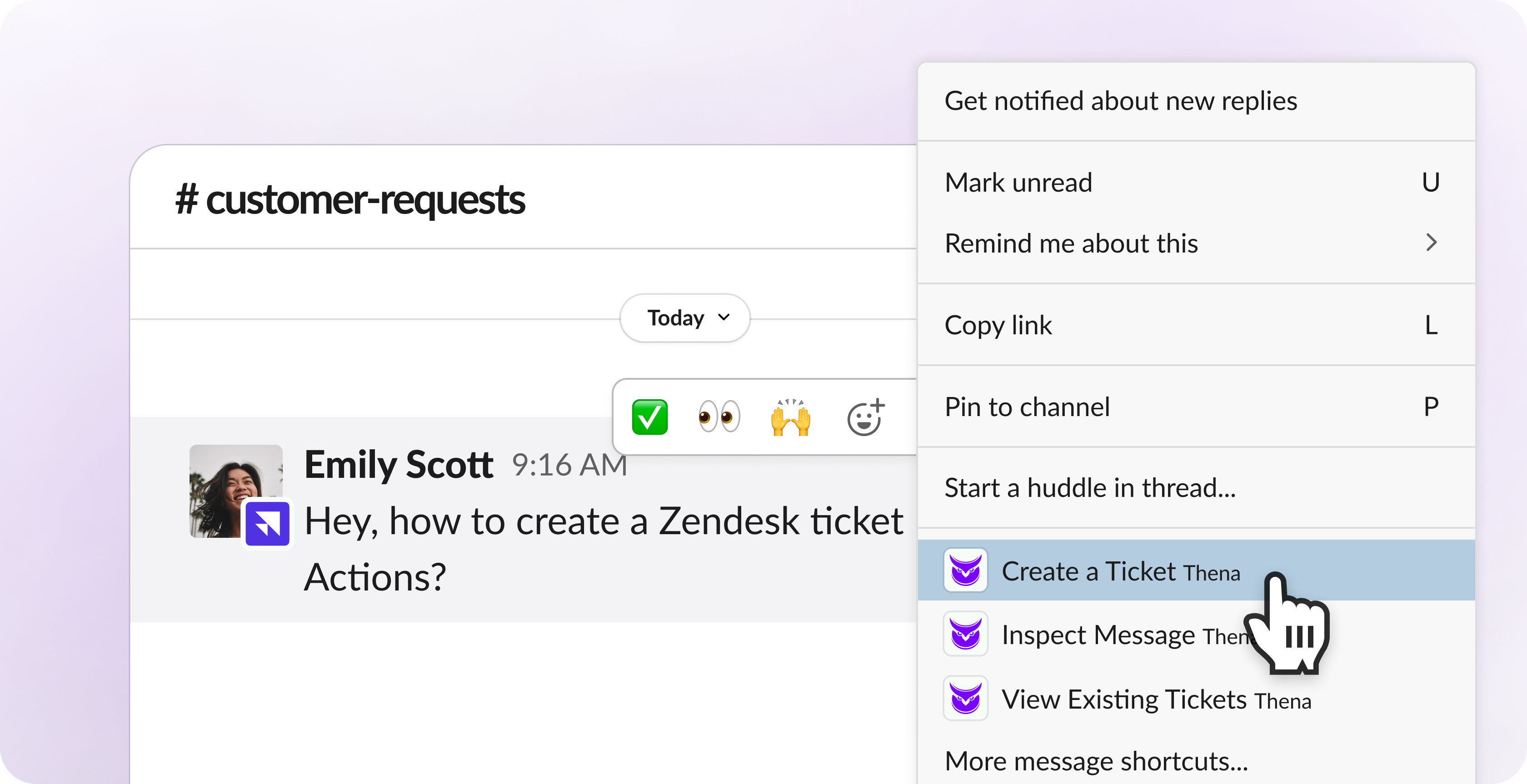
- Using Thena triage channel or app home
As a vendor, you can create a ticket from the Thena triage channel or the Thena app home, by clicking on the "New Zendesk ticket" button once the customer message is detected as a request.
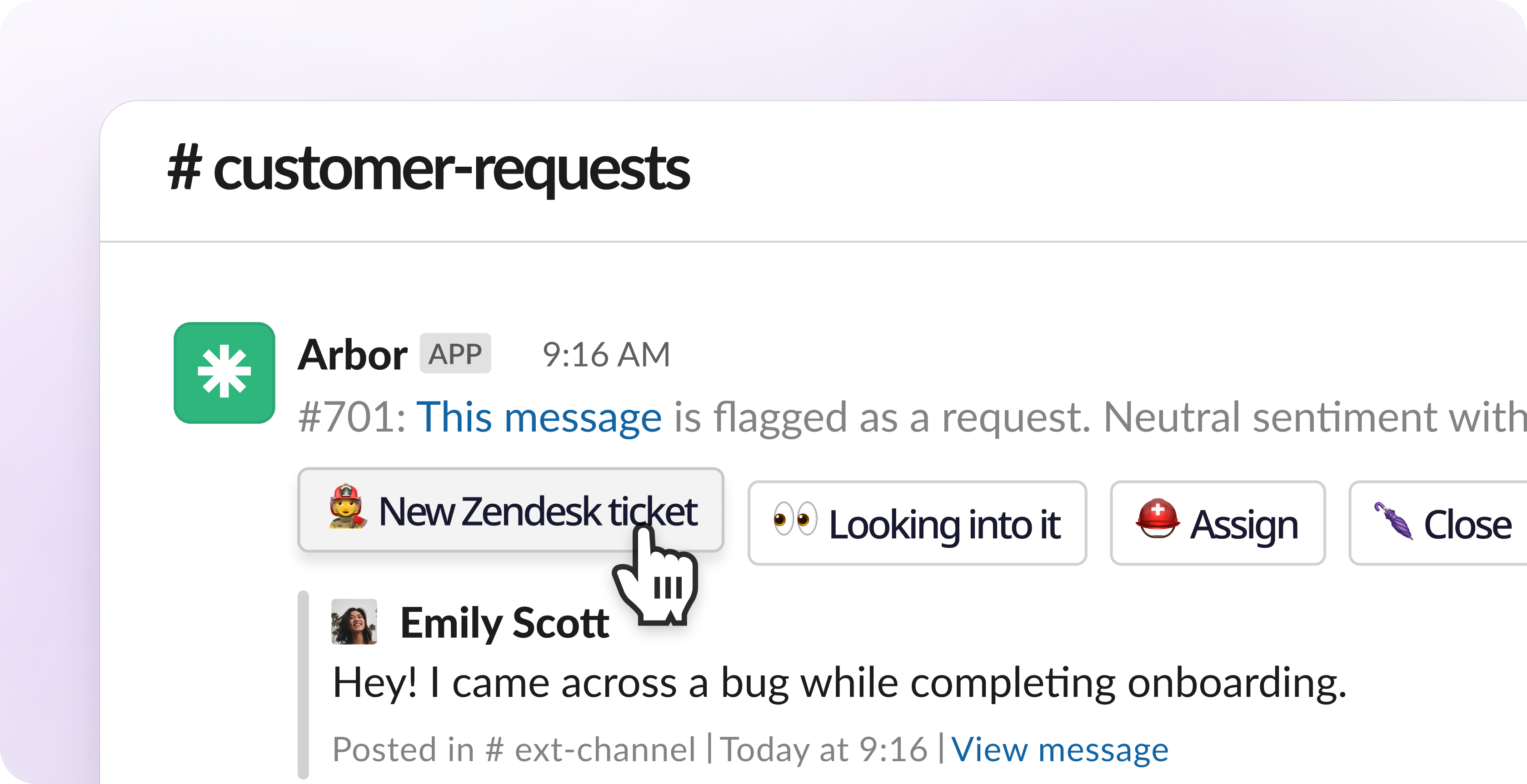
Below is an example of a form that pops up when a user selects to create a Zendesk ticket using any of the above mentioned methods.
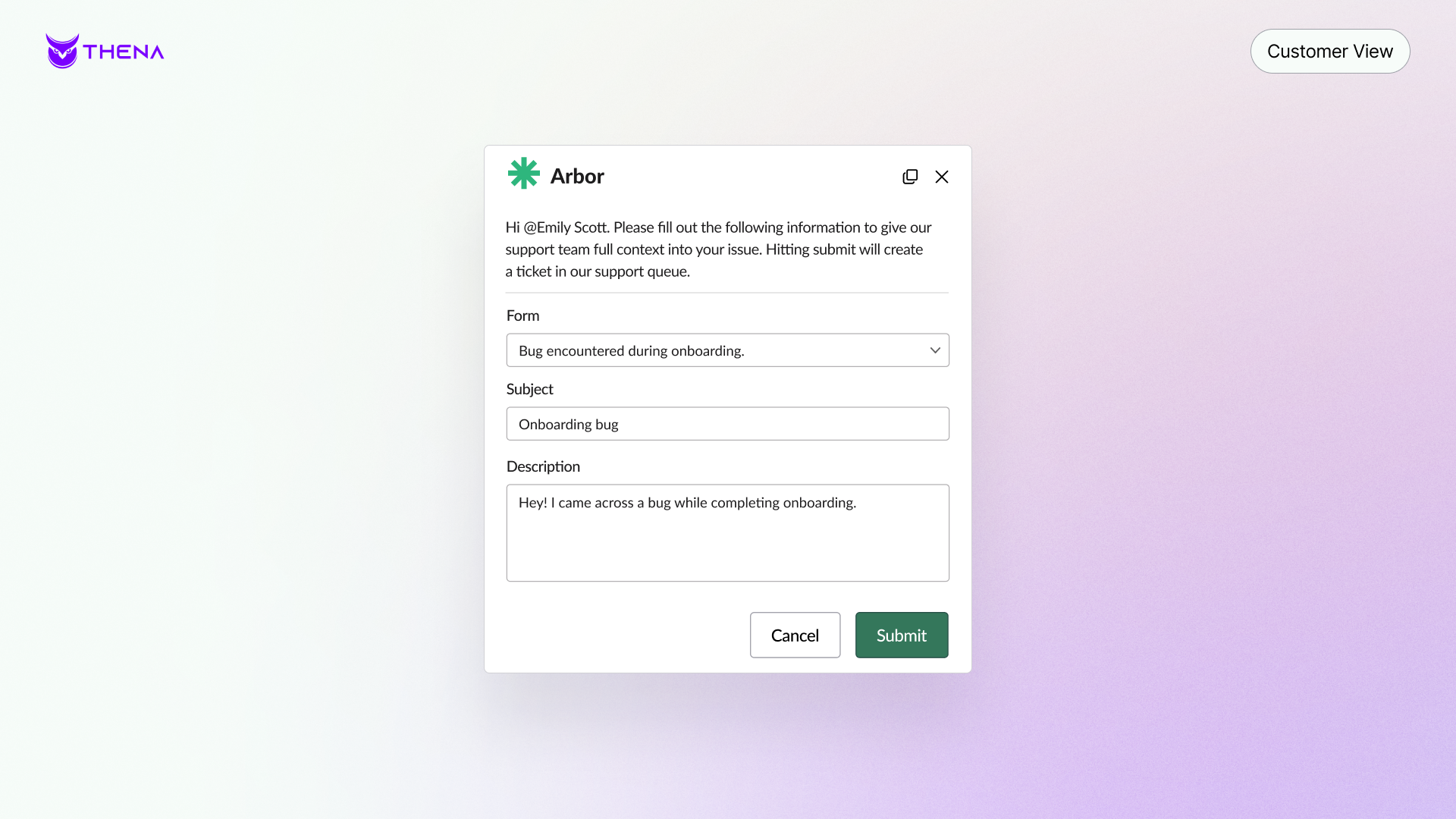
Bidirectional comments sync
Comments on a ticket thread are synced across Zendesk, Slack and web app. Comments made in any of these platforms are mirrored in the others. Edits or deletions of comments are also updated consistently across all platforms.
Below provides a comprehensive comparison of features in the bidirectional comments sync between Slack and Zendesk.
Rich text formatting
| Feature | Slack to Zendesk | Zendesk to Slack |
|---|---|---|
| Bold text | ✔ | ✔ |
| Italic text | ✔ | ✔ |
| Underlined text | ❌ | ❌ |
| Strikethrough text | ✔ | ✔ |
| Colored text | ❌ | ❌ |
| Bulleted lists | ✔ | ✔ |
| Numbered lists | ✔ | ✔ |
| Indented text | ✔ | ✔ |
| Quoted text | ✔ | ✔ |
| URLs in Messages | ✔ | ✔ |
| Hyperlinks in Messages | ✔ | ✔ |
| Inline Code | ✔ | ✔ |
| Code Blocks | ✔ | ✔ |
Attachments
| Feature | Slack to Zendesk | Zendesk to Slack |
|---|---|---|
| PDF files | ✔ | ✔ |
| Word documents | ✔ | ✔ |
| Excel spreadsheets | ✔ | ✔ |
| PowerPoint presentations | ✔ | ✔ |
| Audio files | ✔ | ✔ |
| Video files | ✔ | ✔ |
| Zip files | ✔ | ✔ |
| Text files | ✔ | ✔ |
| CSV files | ✔ | ✔ |
| GIF files | ✔ | ✔ |
| JPEG images | ✔ | ✔ |
| PNG images | ✔ | ✔ |
| BMP images | ✔ | ✔ |
| SVG images | ✔ | ✔ |
| PDF documents | ✔ | ✔ |
| Word documents | ✔ | ✔ |
| Excel spreadsheets | ✔ | ✔ |
| PowerPoint presentations | ✔ | ✔ |
| Text files | ✔ | ✔ |
| MP3 audio files | ✔ | ✔ |
| WAV audio files | ✔ | ✔ |
| MP4 video files | ✔ | ✔ |
| AVI video files | ✔ | ✔ |
File size exceeding limitsIn the scenario of an attachment, a file (which is greater than
50MBon Slack) is added to a comment/message respectively, the attachment would not be posted to the destination due to the file size limit imposted by Zendesk.
Emojis
| Feature | Slack to Zendesk | Zendesk to Slack |
|---|---|---|
| Standard emojis on messages | ✔ | ✔ |
| Emoji reactions to messages | ❌ | ❌ |
| Custom emojis on messages | ❌ | ❌ |
Link previews
| Feature | Slack to Zendesk | Zendesk to Slack |
|---|---|---|
| Website link previews | ❌ | ✔ |
| Video link previews | ❌ | ✔ |
| Image link previews | ✔ | ✔ |
Mentions are not supported between Slack and Zendesk
Multiple Zendesk instances & form management
Thena allows linking different Zendesk forms to specific channels, tailored to distinct business needs. Users can:
- Select Zendesk instances via the Helpdesk field
- Choose forms for an individual channel or all channels based on the Zendesk instance
Comprehensive field retrieval
While filling the fields to either create or close a ticket, the values are fetched from Zendesk real time to ensure that the available field values are always in sync with Zendesk. For instance, if you have a field of 'Product version' which is updated in Zendesk via triggers each time you release a new product version, this new version will be synced with Thena forms automatically.
Support for Zendesk field permissions
| Zendesk attribute | Definition | Usage |
|---|---|---|
| Required to submit a request | This signifies that the field is mandatory for ticket creation | When this attribute is set, it means the corresponding field must be filled or selected before the ticket can be closed. |
| Required to solve a ticket | This indicates that the field is necessary for closing the ticket | When this attribute is set, it means the corresponding field must be filled or selected when creating a new ticket through the Zendesk portal. |
| Customers can view | This indicates that the field value is visible to customers, but can’t be edited | You can choose to hide/show this field by clicking on the gear icon next to the form under "Forms and Fields" on the Thena web app. If shown, customers can only view but not edit the field. |
Support for field type mapping between Thena and Zendesk
To enhance compatibility, the Zendesk field types are mapped to corresponding Thena/Slack field types:
| Zendesk Type | Thena/Slack Type to Use |
|---|---|
| Drop-down (tagger) | Single Select |
| Multi-select | Multi Select |
| Text | Plain Text |
| Multi-line | Multi-line Text |
| Checkbox | Checkbox |
| Numeric | Plain Text |
| Decimal | Plain Text |
| Date | Date |
| Regex | Plain Text |
'Lookups' are not supported
Standard & custom fields sync
Users can modify various fields, including custom fields and standard fields
| Field | Possible values in Thena | Sync supported |
|---|---|---|
| \Status | Open | In Progress | Closed | ✔ |
| Urgency/Priority | Low, Medium, High, Critical and more | ✔ |
| Assignee | Usernames or IDs of available agents | ✔ |
| Requestor | Email addresses or usernames of users | ✔ |
| Title | Text | ✔ |
| Description | Text | ✔ |
| Tags | Array of labels or tags | ✔ |
| CSAT | Ratings | ❌ |
Support for re-opening tickets
Thena can reopen 'Closed' tickets or generate follow-up tickets on Zendesk in response to customer replies within an existing ticket thread. Before attempting to reopen a ticket, we check its status on Zendesk. If the ticket is 'closed', we let Zendesk create a follow-up ticket, using the new customer message posted on the channel.
Note: Follow up tickets and reopening of tickets can only be done on customer messages on the thread and not on vendor messages on the thread.
You can configure a duration for 'solved' tickets to move into 'closed' on Zendesk. Once this duration has passed, tickets cannot be reopened as Zendesk treats 'closed' state to be the final state of a ticket. Thena creates a follow up ticket for such cases and updates the same on the Slack thread. Refer Zendesk documentation
Refer to this usecase for more understanding on Reopening of tickets.
Getting started
Pre-requisites
- Zendesk API Token - Generate a new API token by following the steps outlined in the Zendesk documentation here. Avoid using an existing token to prevent potential issues should the token be removed.
- Set up Thena Request Management on Slack by consulting the documentation here.
Integrating Zendesk
Follow these steps to integrate Thena with Zendesk
- Go to Integrations in your Thena Web App 's Global settings
- Click on 'Add Integration' under the Zendesk integration
Step 1. Authentication
You should see the following modal once you click on "Add Integration"
Provide the following information:
- Username: Your Zendesk login email
- Token: Obtain this from the Zendesk API Token
- Base URL: Follows the format: https://[workspace name].zendesk.com/api/v2
For example, if your workspace is named acme, the URL would be https://acme.zendesk.com/api/v2.
Click on "Test connection" to automatically create webhooks, triggers, and fetch Zendesk forms & fields
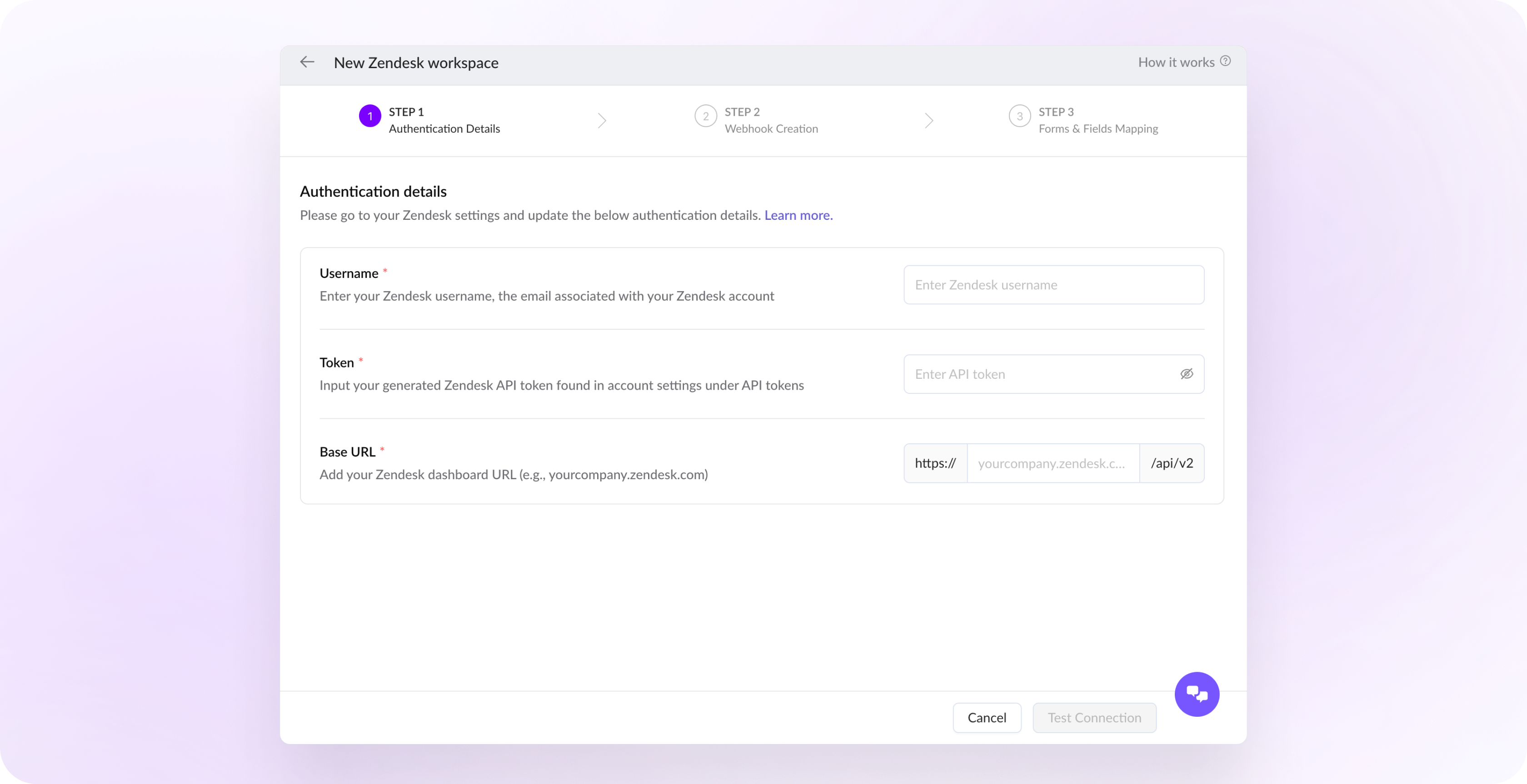
Step 2. Webhooks & Triggers
Once the actions are complete, your integration with Zendesk is up and running! Click on "Next" to continue.
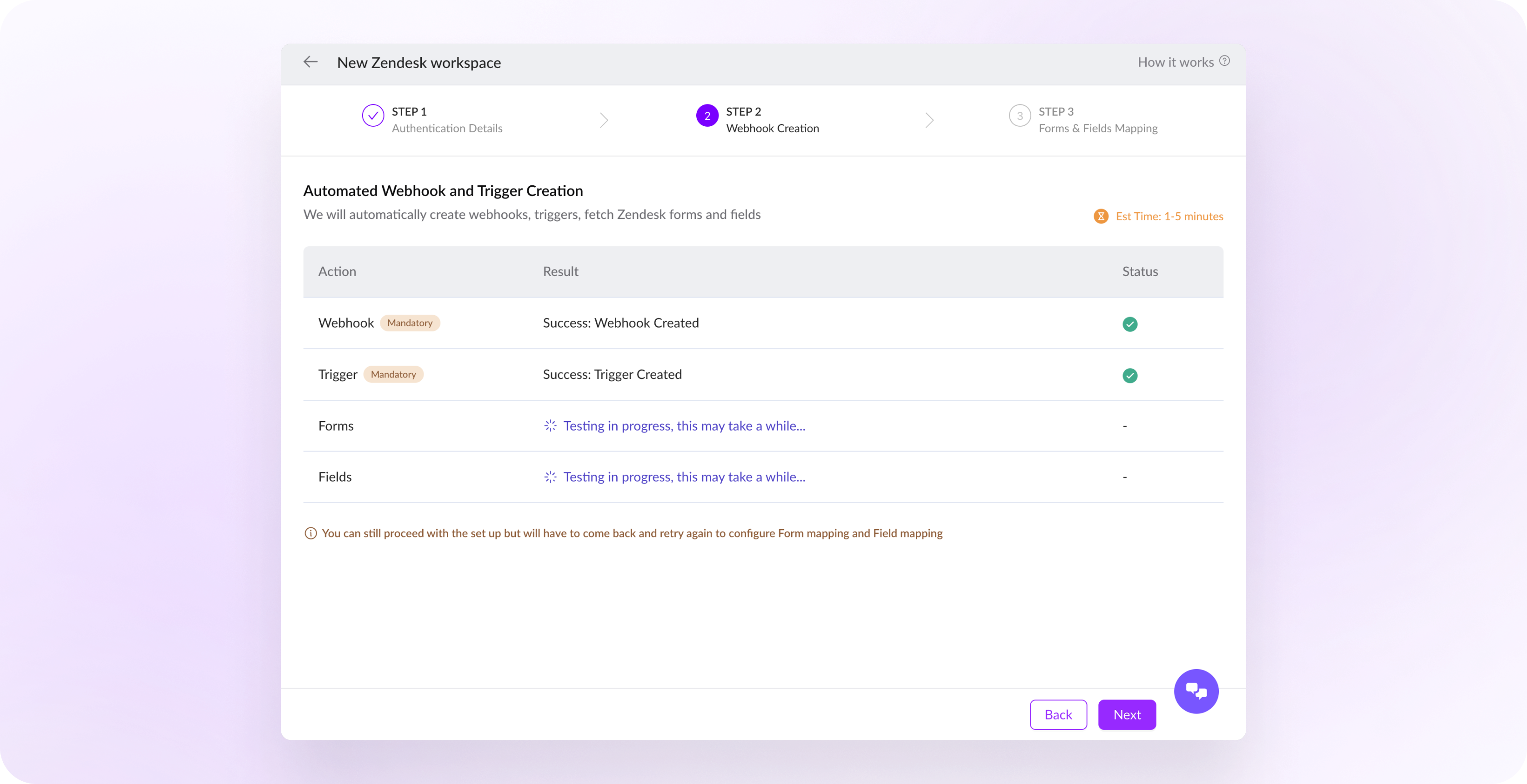
The syncing of forms and fields might take upto 1-5 minutes
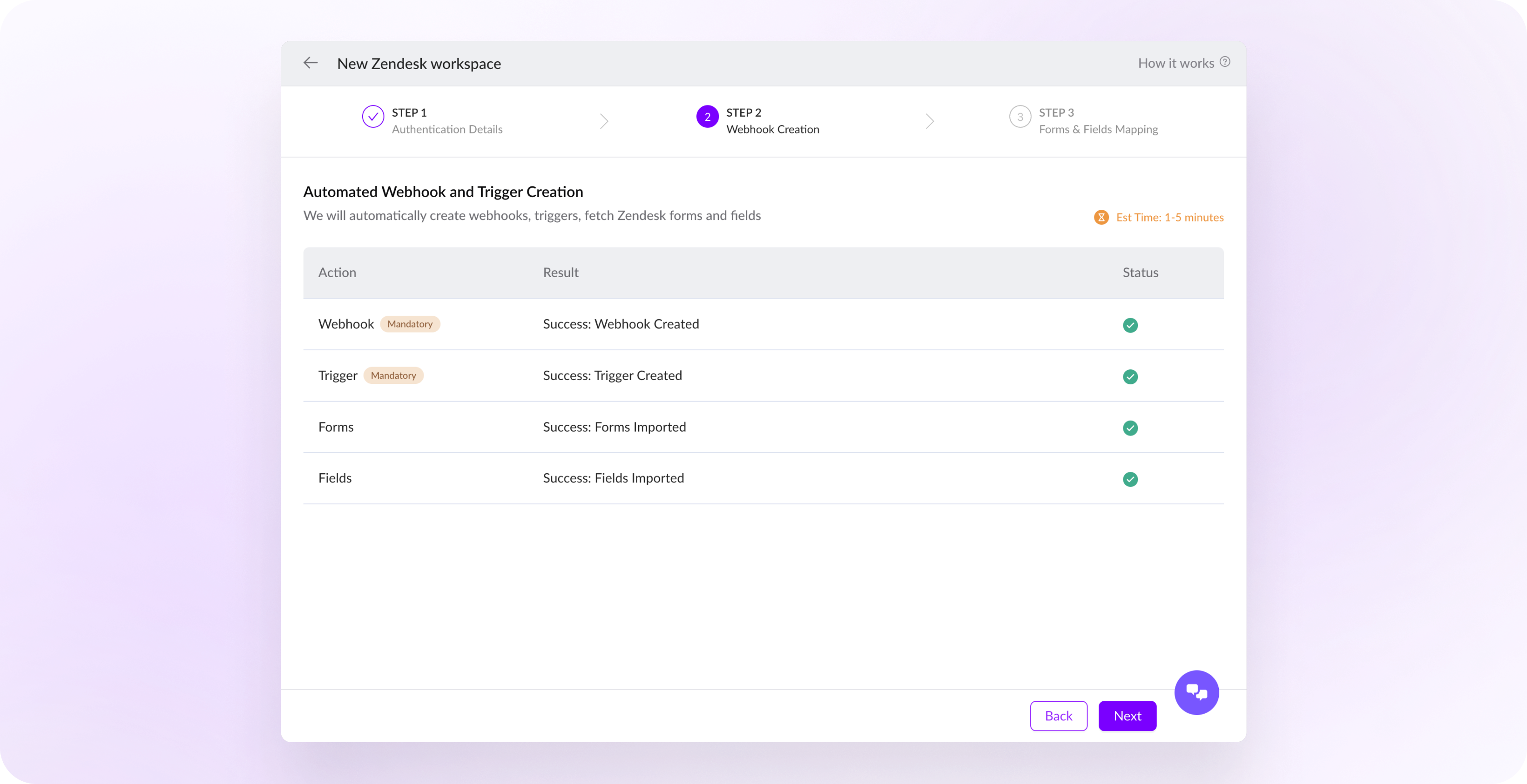
Webhook & Trigger creation is mandatory; if it fails, you won't be able to proceed.Non-mandatory steps like fetching forms & fields can be configured later.
Step 3. Forms & Fields Config
Form mapping is a crucial aspect of integrating Zendesk with Slack for efficient ticket creation. It involves configuring how information on Zendesk forms is presented on Slack channels.
Form Mapping
Global Configurations
- Select form that will be applicable across your Slack channels unless overridden by channel specific configurations
- When multiple forms are selected here, user is provided with an option to choose between these forms during ticket creation in Slack, unless a channel level configuration is provided.
Channel Configurations
- For a more granular control, you can configure channel-specific settings determining which Zendesk form is shown on each channel.
- This ensures that the integration accommodates different forms associated with distinct Zendesk instances
Refer this usecase for more understanding on multiple form configuration.
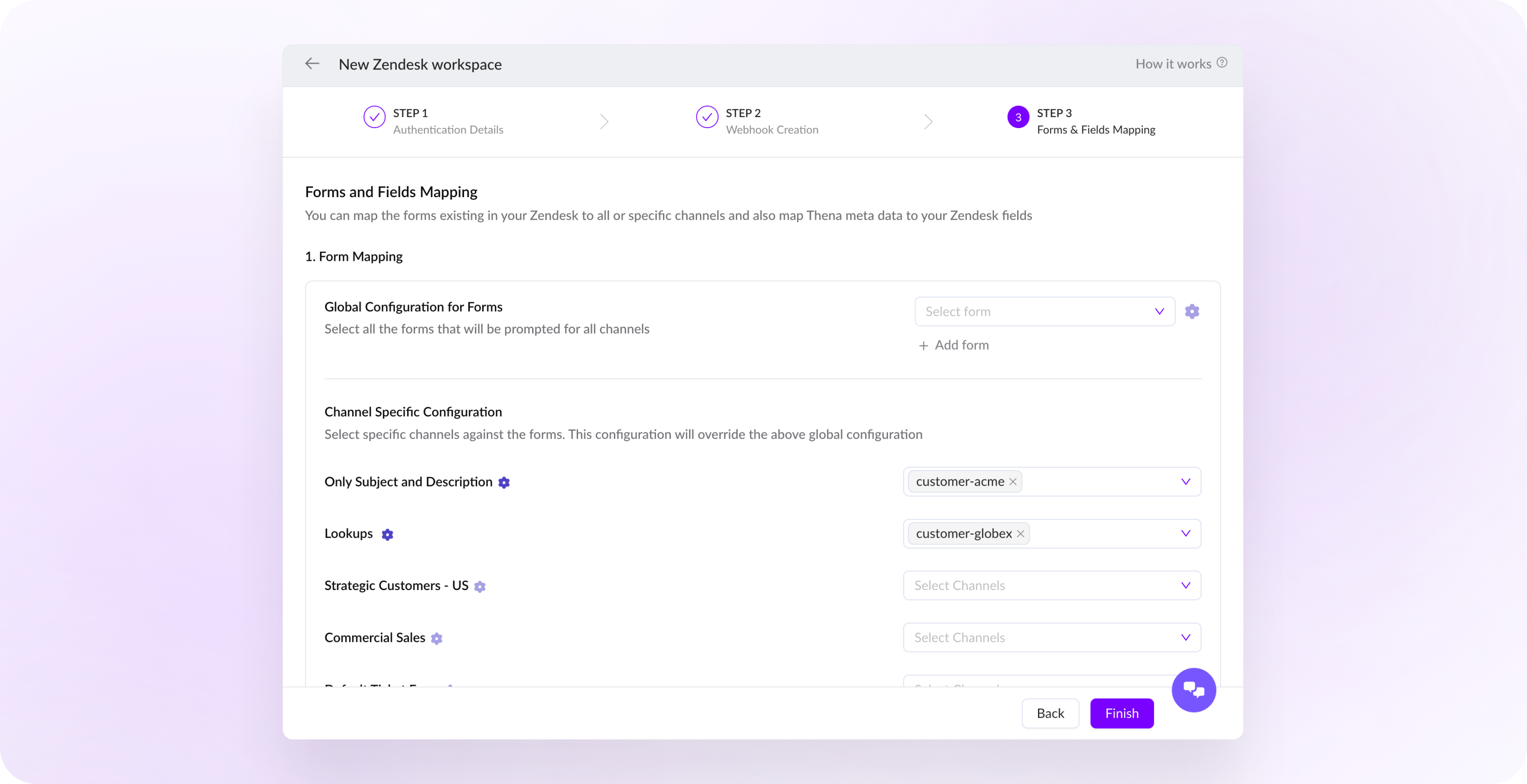
Channel-specific configurations override the global settings, allowing for flexibility in different communication channels
Field Mapping
Field mapping is crucial for aligning Zendesk fields with Thena metadata, facilitating the streamlined exchange of data. This guarantees accurate information transfer between Thena and Zendesk during ticket creation.
Refer this Zendesk documentation for creating fields on Zendesk
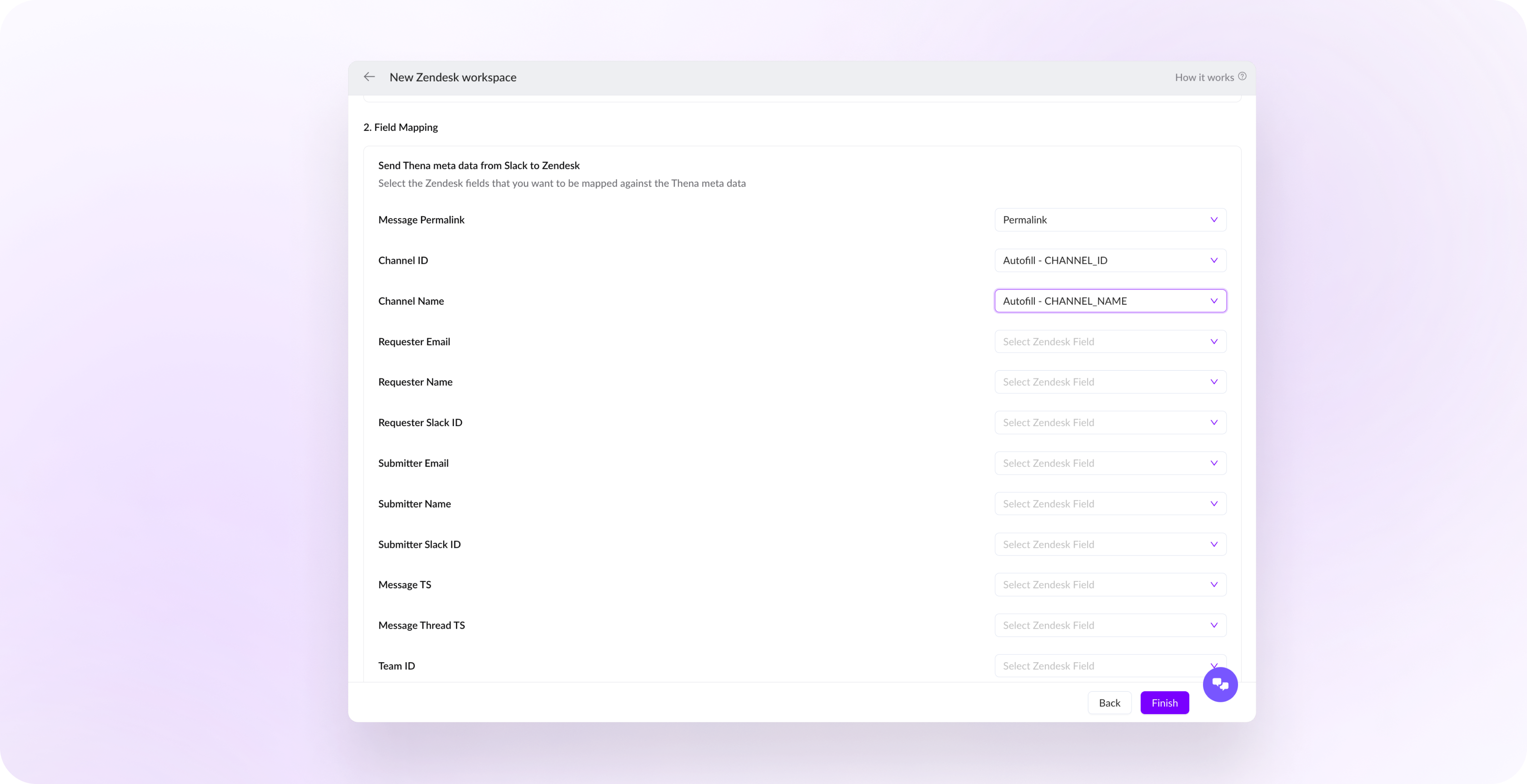
The fields on the left represent metadata held by Thena, which you can map to the corresponding Zendesk fields available from the dropdown on the right.
| Fields Name | Type | Description |
|---|---|---|
| Message Permalink | URL | The Slack redirect url of the message that was converted into a Zendesk ticket |
| Channel ID | Plain Text | Slack channel ID where the ticket was created |
| Channel Name | Plain Text | Slack channel name where the ticket was created |
| Requester Email | Email ID | Email of the customer who sent the message on Slack |
| Requester Name | Plain Text | Name of the customer who sent the message on Slack |
| Requester Slack ID | Plain Text | Slack user id of the customer who sent the message on Slack |
| Submitter Email | Email ID | Email of the user who created the ticket (vendor or customer) |
| Submitter Name | Plain Text | Name of the user who created the ticket (vendor or customer) |
| Submitter Slack ID | Plain Text | Slack user id of the user who created the ticket (vendor or customer) |
| Message TS | Plain Text | TS of the Slack message (can be a threaded message) linked to the ticket |
| Message Thread TS | Plain Text | Original message in the Slack thread |
| Team ID | Plain Text | Vendor Slack team id |
| Team Name | Plain Text | Vendor Slack team name |
| Customer Team ID | Plain Text | Customer Slack team id |
| Customer Team Name | Plain Text | Customer Slack team name |
| Form ID | Plain Text | Zendesk form id used to create the ticket |
| Channel Type | Plain Text | Type of Slack channel. Eg : "Slack Connect" |
Refer to this use case for Field Mapping for a better understanding
Advanced configuration for Zendesk on Slack
Thena offers advanced configuration options to customize the behavior of the Zendesk integration within your Slack workspace. You can tailor how tickets are previewed, created, and managed, with the option to configure settings globally, ensuring consistency across your integration. Additionally, you have the flexibility to exclude specific channels where these settings should not apply.
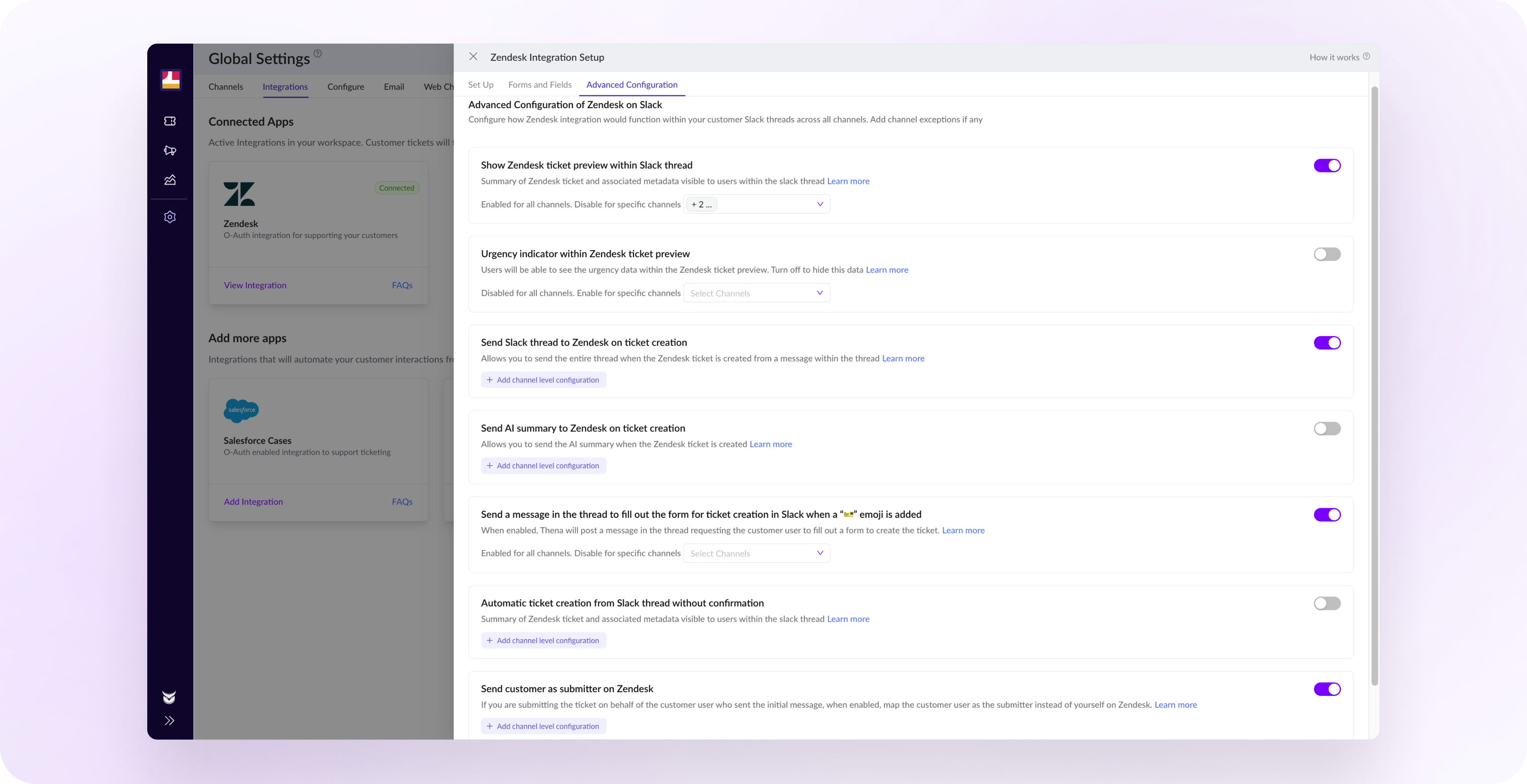
- Zendesk Ticket Preview within Slack Thread: Toggle this to enable/disable the preview of Zendesk tickets in Slack. Channel exceptions can be specified.
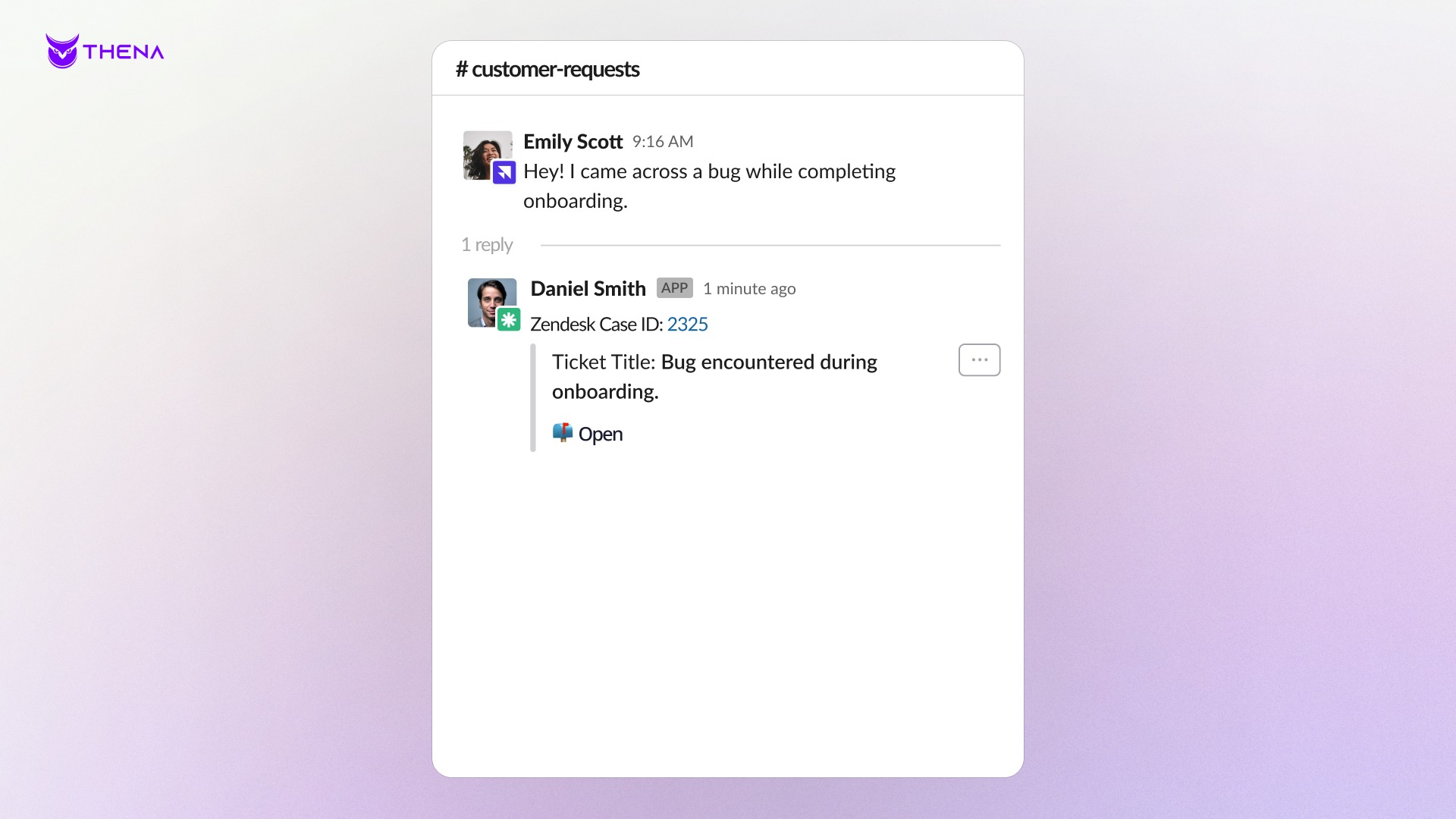
- Urgency Indicator within Zendesk Ticket Preview: Switch this on to display urgency indicators in ticket previews. Channel exceptions can be specified.
- Send Slack Thread to Zendesk on Ticket Creation: If enabled, all conversations in the thread prior to ticket creation will also be synced on Zendesk. Note: comments in the thread, post ticket creation will sync as usual irrespective of this setting. Channel exceptions can be specified.
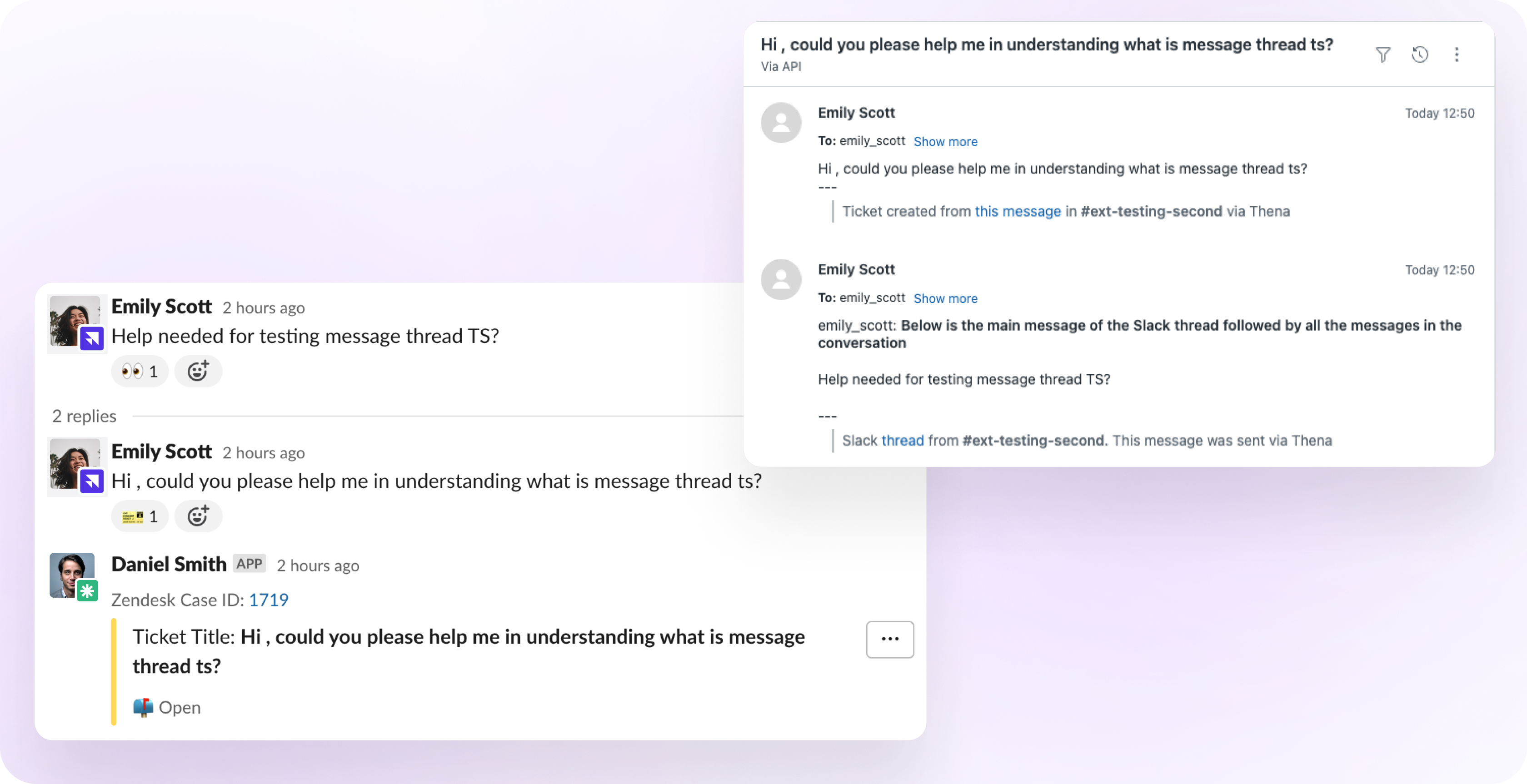
- Send AI Summary to Zendesk on Ticket Creation: On creation of ticket, include the AI Summary generated by Thena to Zendesk. Channel exceptions can be specified.
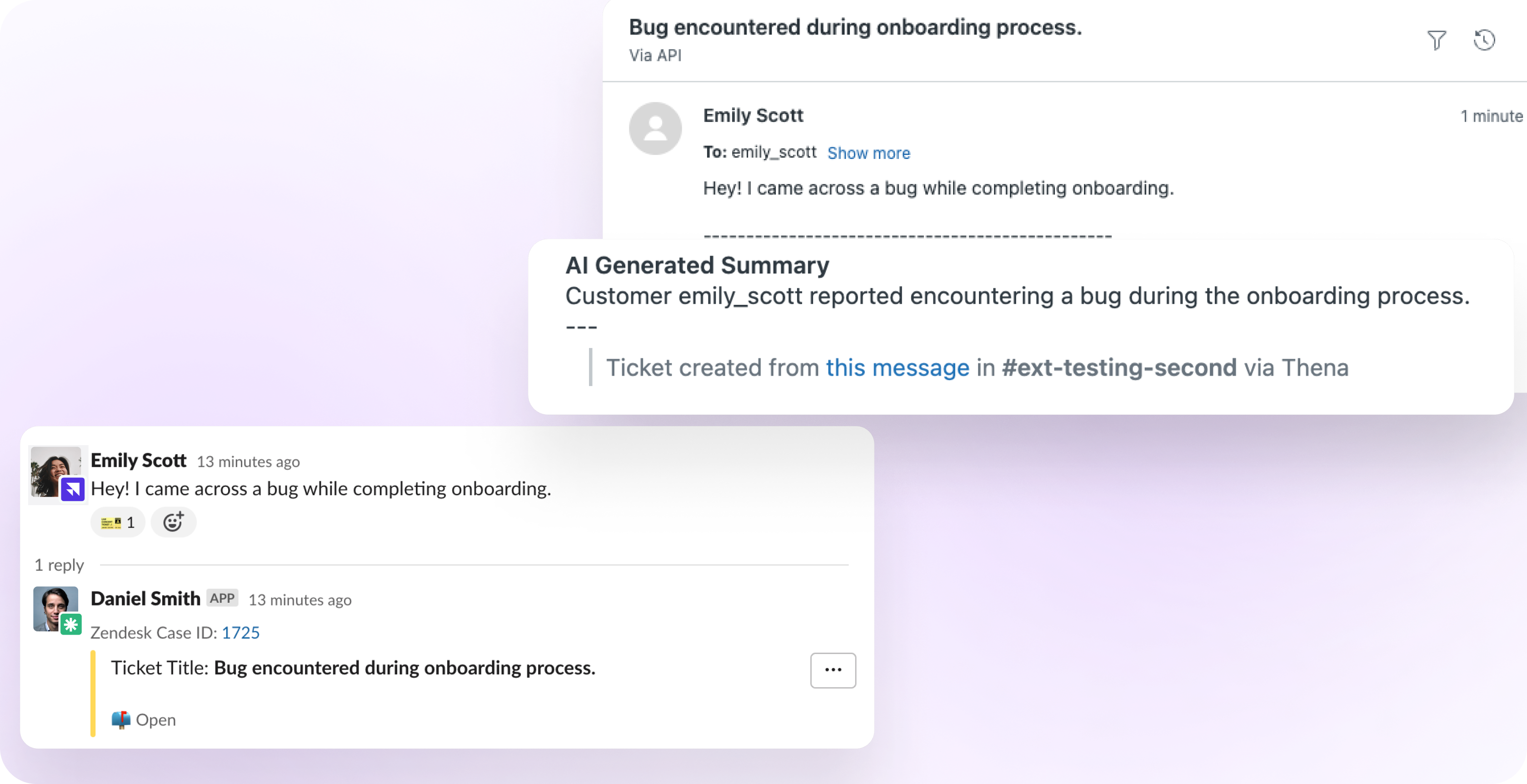
- Send a message in the thread to fill out the form for ticket creation in Slack when "🎫" emoticon is added : You can use the "🎫" reaction on Slack messages to create tickets. When this configuration is enabled, adding the "🎫" reaction will trigger the ticket creation form, which you can fill and create a ticket. When disabled, adding the "🎫" reaction will create tickets automatically. Note: If the selected form has mandatory fields, you will need to fill in these details as an additional step. Channel exceptions can be specified.
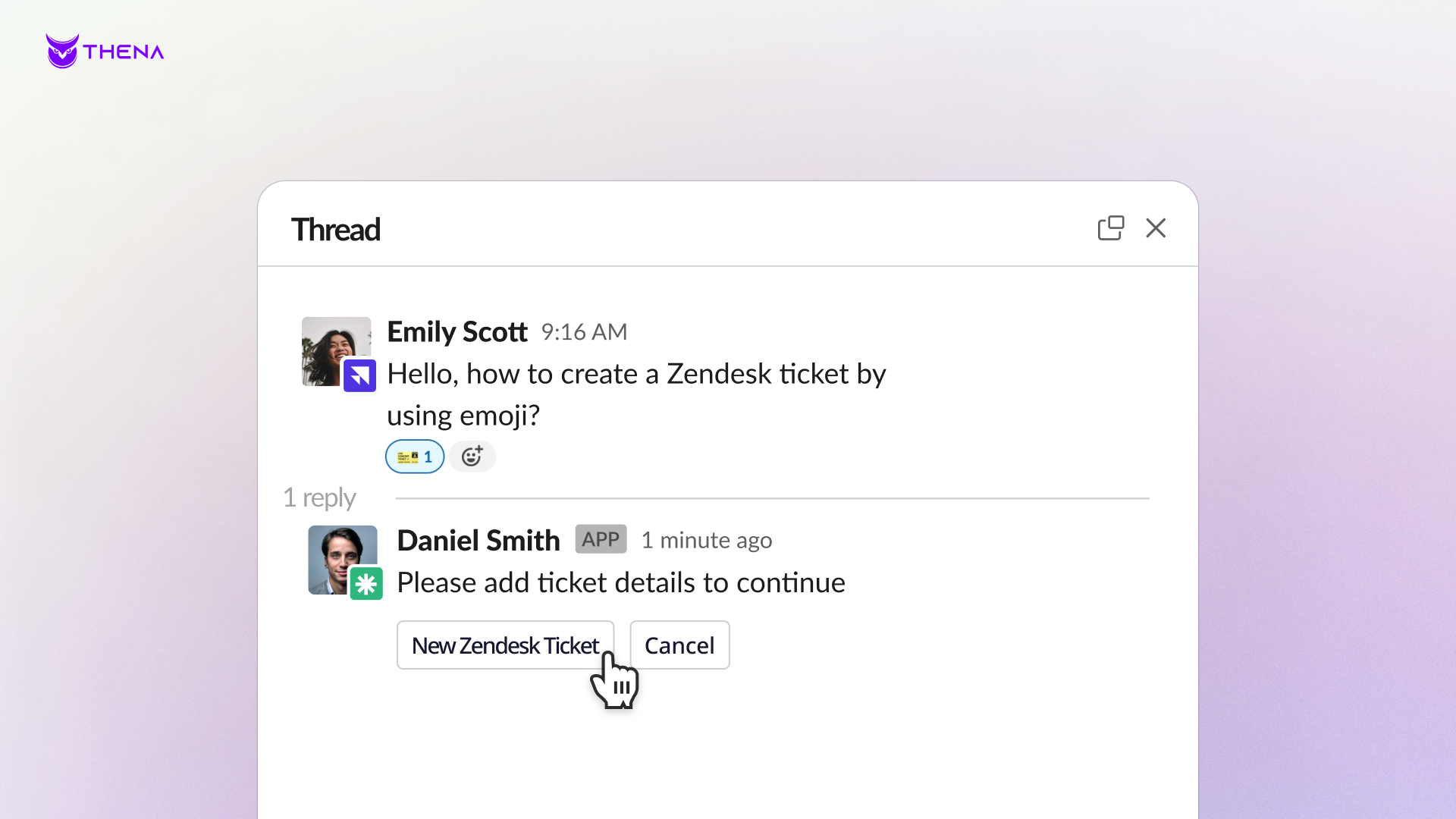
- Automatic Ticket Creation from Slack Thread Without Confirmation: When Thena detects a message as a request, auto convert the thread into a Zendesk ticket. Channel exceptions can be specified.
Note : If your form has mandatory fields on ticket creation, auto-create ticket feature will require manual inputs in completing these fields.
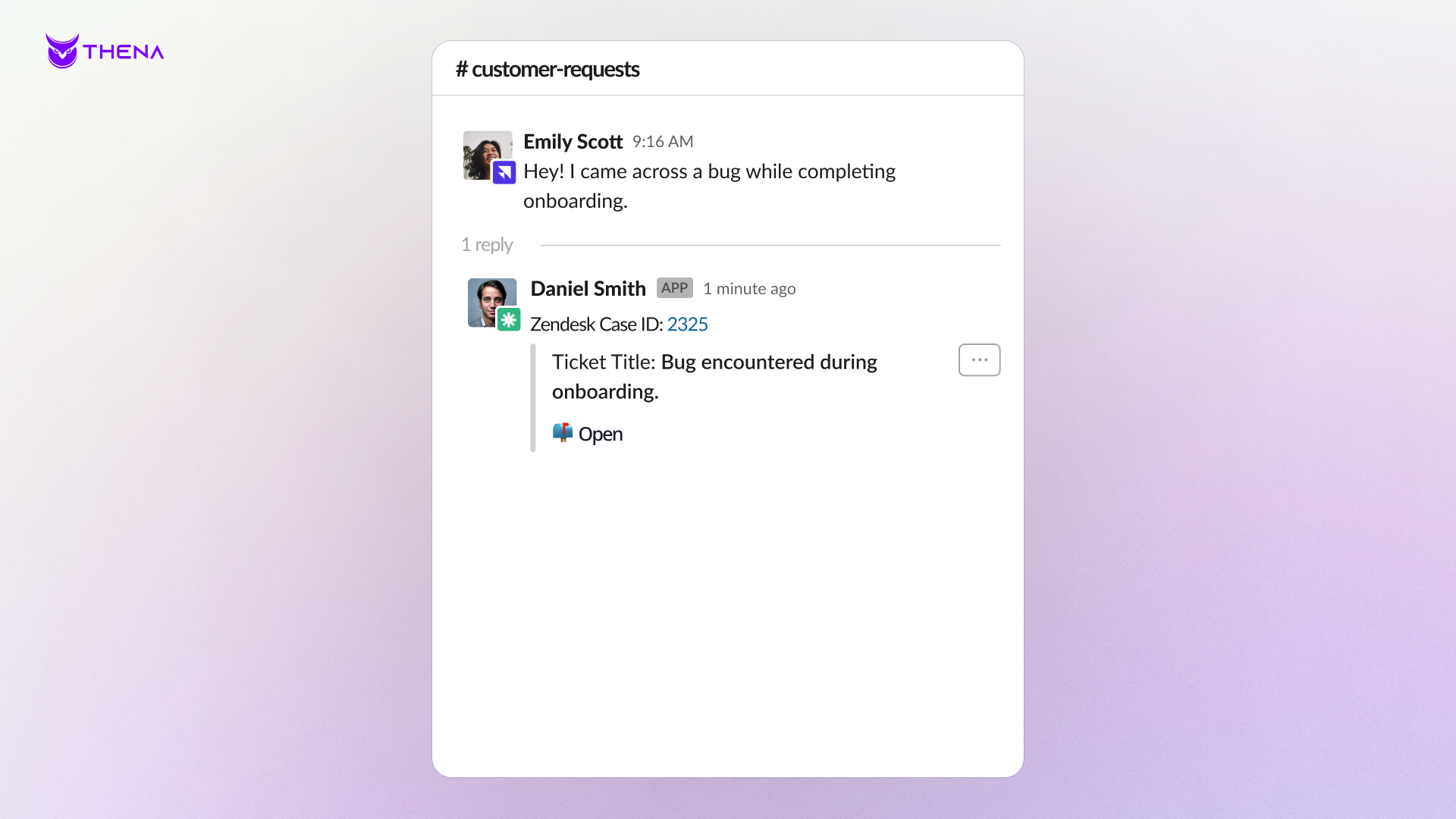
If no form is selected during the setup process (either globally or at the channel level), Thena will default to using the first form available.
- Send Customer as submitter on Zendesk: Enabling this feature ensures that the customer is listed as the requester on Zendesk, even when you, as the vendor create the ticket in the customer's thread. Channel exceptions can be specified.
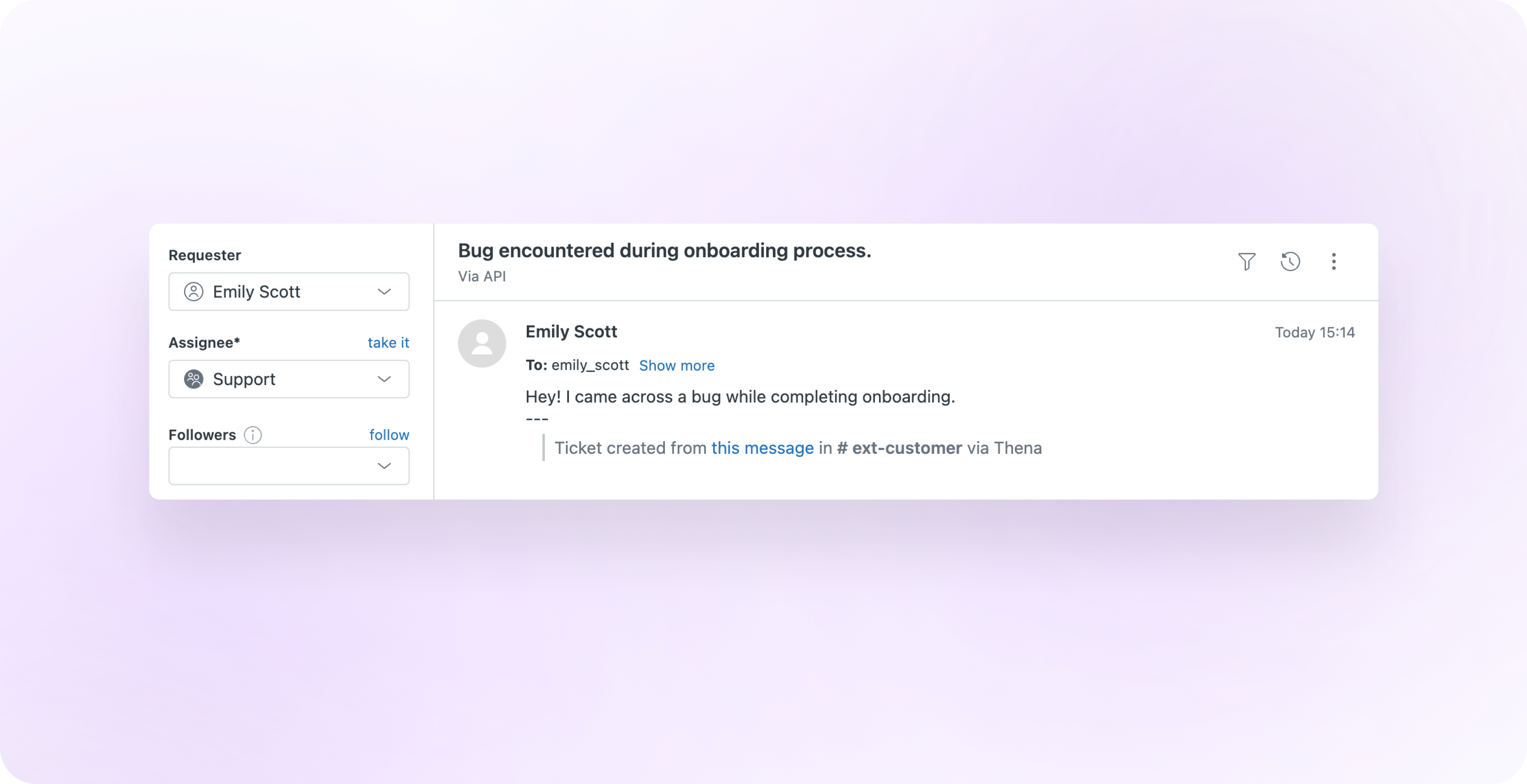
- Allow ticket creation with "🎫" emoji: Disabling this option will prevent Thena from creating a ticket or prompting the user to complete a form for ticket creation when the ticket emoji is used.
Ensure to review channel exceptions to fine-tune the integration as per your team's workflow.
Configure multiple Zendesk instances
You can add multiple Zendesk instances during setting up Zendesk configurations on Thena one by one. On the Setup screen, click on "Add new helpdesk" option to proceed adding another instance.
You can also view & edit the existing Zendesk instance setup details by clicking on it.
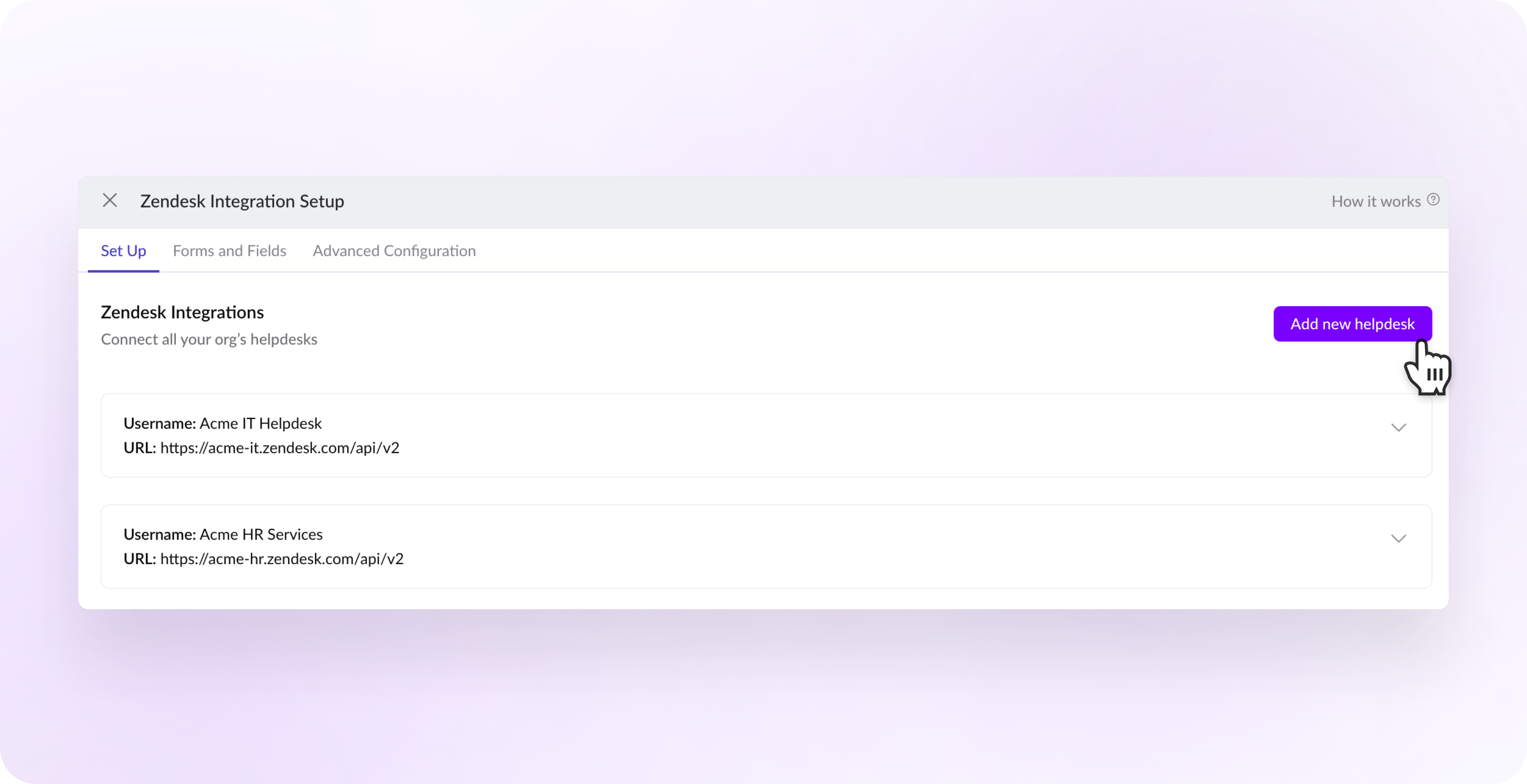
Multiple Zendesk instances
For more understanding on multiple Zendesk instances configuration on Thena, refer this usecase.

Use Cases
Single Zendesk instance
Single form configuration
The simplest method to generate Zendesk tickets from Slack channels is to set up just one form within your Zendesk instance. This form can be specialized and designed to serve a specific customer group, as it won't offer varied fields for different customer types. For instance, consider a standard form for an IT Helpdesk department, equipped with a comprehensive description box that allows customers to detail and submit their issues.
Multiple form configuration
You can customize your Zendesk setup with multiple forms for various customer needs or issues. For instance, your IT Helpdesk could have distinct forms for new employee onboarding, security incidents, or software problems. With Thena, you can pre-configure these forms or select the right form when creating a ticket from Slack.
- Globally configure the form - you can configure a specific form at the global level and this would skip user selection of forms on ticket creation. Refer here for global specific form configuration.
- Configure for specific channels - Refer here for channel specific form configuration.
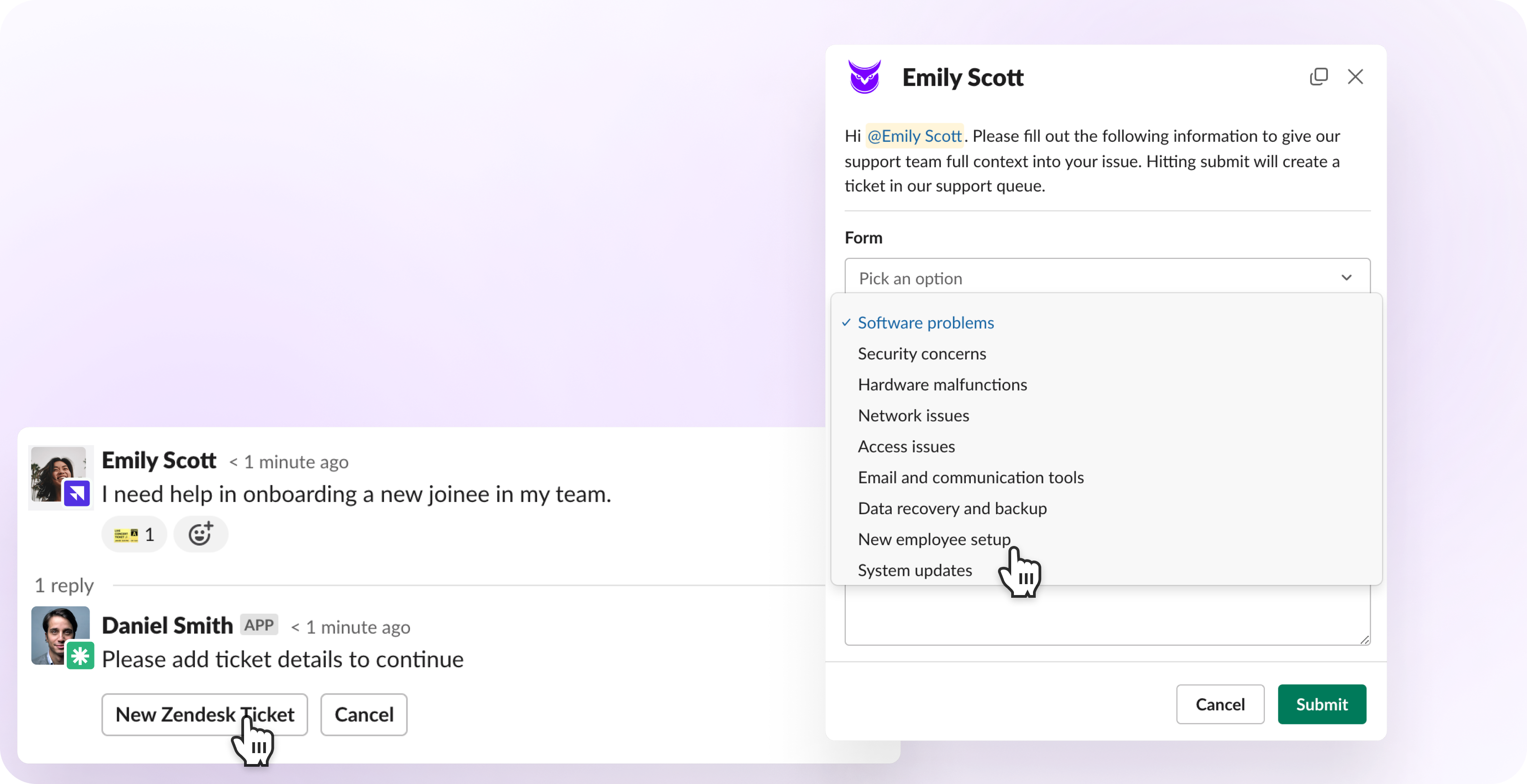
Form selection during ticket creation on Slack
Multiple Zendesk instances
To further effectively meet diverse customer needs, you can utilize multiple Zendesk instances, each customized for specific departments like IT and HR, with different forms for various scenarios.
Single form configuration
You can bypass the end user to select a form during ticket creation by:
- Setting up only one form belonging to a specific helpdesk under Global form configuration
- Configuring specific channels against the forms of your choice
Multiple form configuration
Thena enhances this setup by allowing you dynamically select the appropriate helpdesk and form when creating tickets directly from Slack.
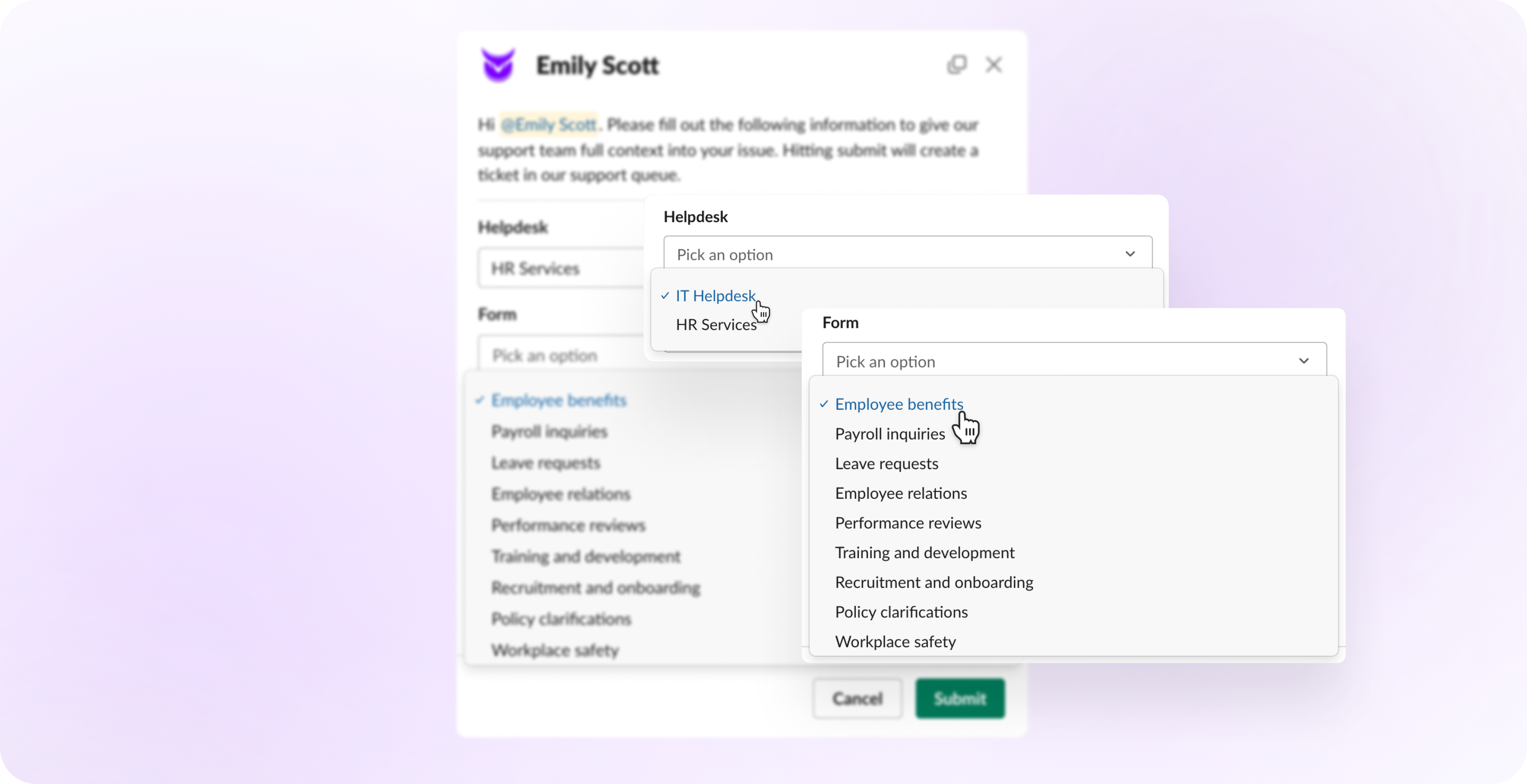
Helpdesk and form selection during ticket creation on Slack
Custom field configuration
Thena metadata
These are fields like Channel Name, Channel ID, Team name, etc that Thena already has and can be sent to Zendesk without requesting it from the end user when a ticket is created.
You can utilize these fields in Zendesk to create automation rules to assign specific SLAs/queues/assignees to the ticket based on your business logic.
For instance, you have 15 strategic customers who enjoy 30 min SLA vs every other customer having 2 hour SLA, you can set an automation rule in Zendesk based on the Team name field to trigger an alert after 30 minutes if there is no response from the agent.
Reopening closed tickets
In the scenario where an agent solves a ticket and the customer sends a follow up query in Slack. Thena identifies this as a message on a closed ticket. Two possibilities here:
- Customer replies within the time configured window of Zendesk's auto close automation rule - Thena reopens the ticket, moving it to 'Open' on Zendesk.
- Customer replies after the time configured window of Zendesk's auto close automation rule - Thena creates a new follow-up Zendesk ticket.
Zendesk <> Thena error mapping
Thena will notify you of any failures related to ticket creation, status updates, or comment synchronization on Zendesk. Updates on these issues can be communicated in the following ways:
- As a response in the thread to the detected request's alert sent in the Thena triage channel andsubsequently broadcasted.
Note: This error notification is sent to the triage channel only if the request which was converted to a ticket had an alert in the triage channel
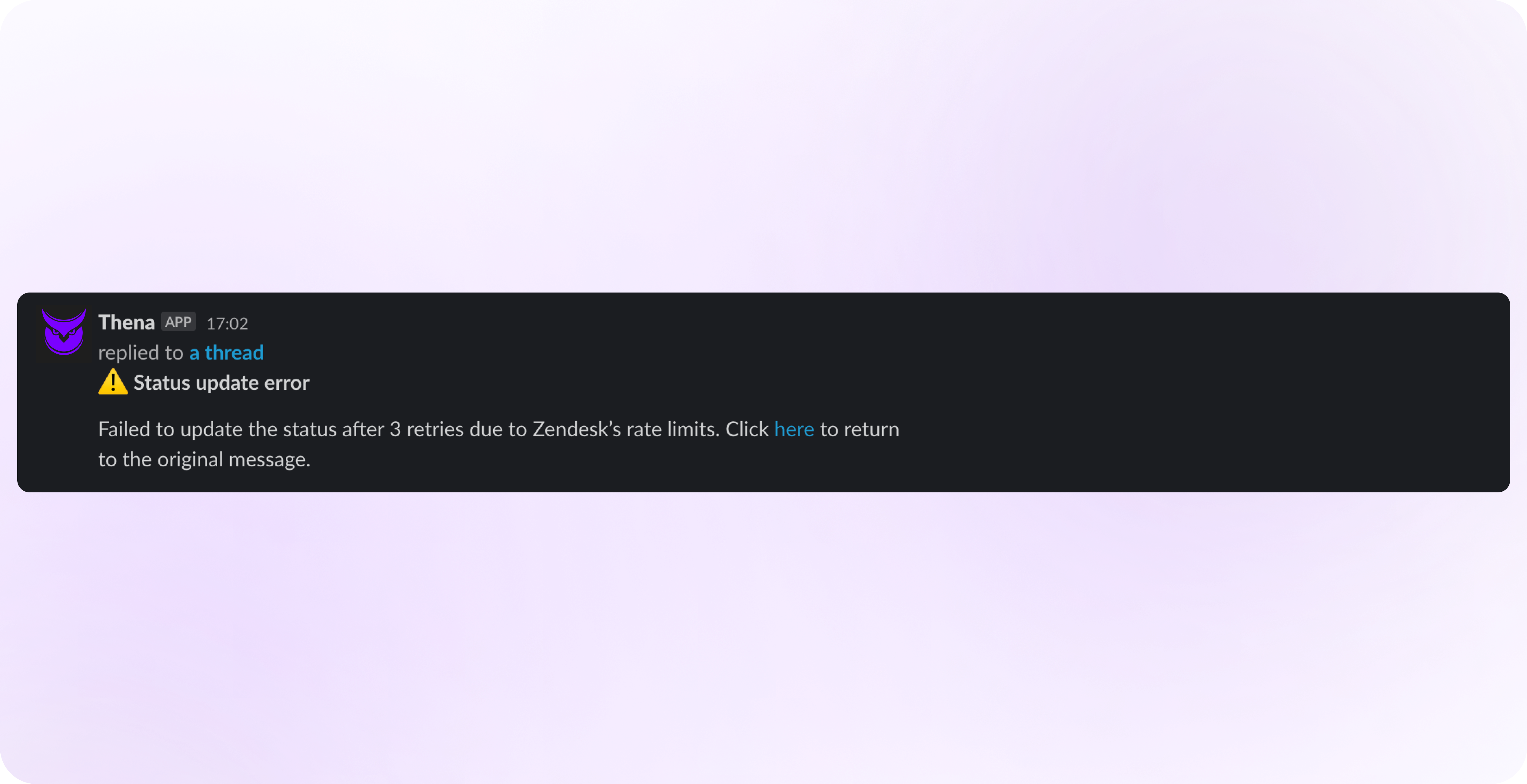
- If a triage channel is not set up at the time of the customer message being detected as a request, the error will be delivered only to the user/admin who has installed Thena in the Slack workspace as a new message from the Thena app home.
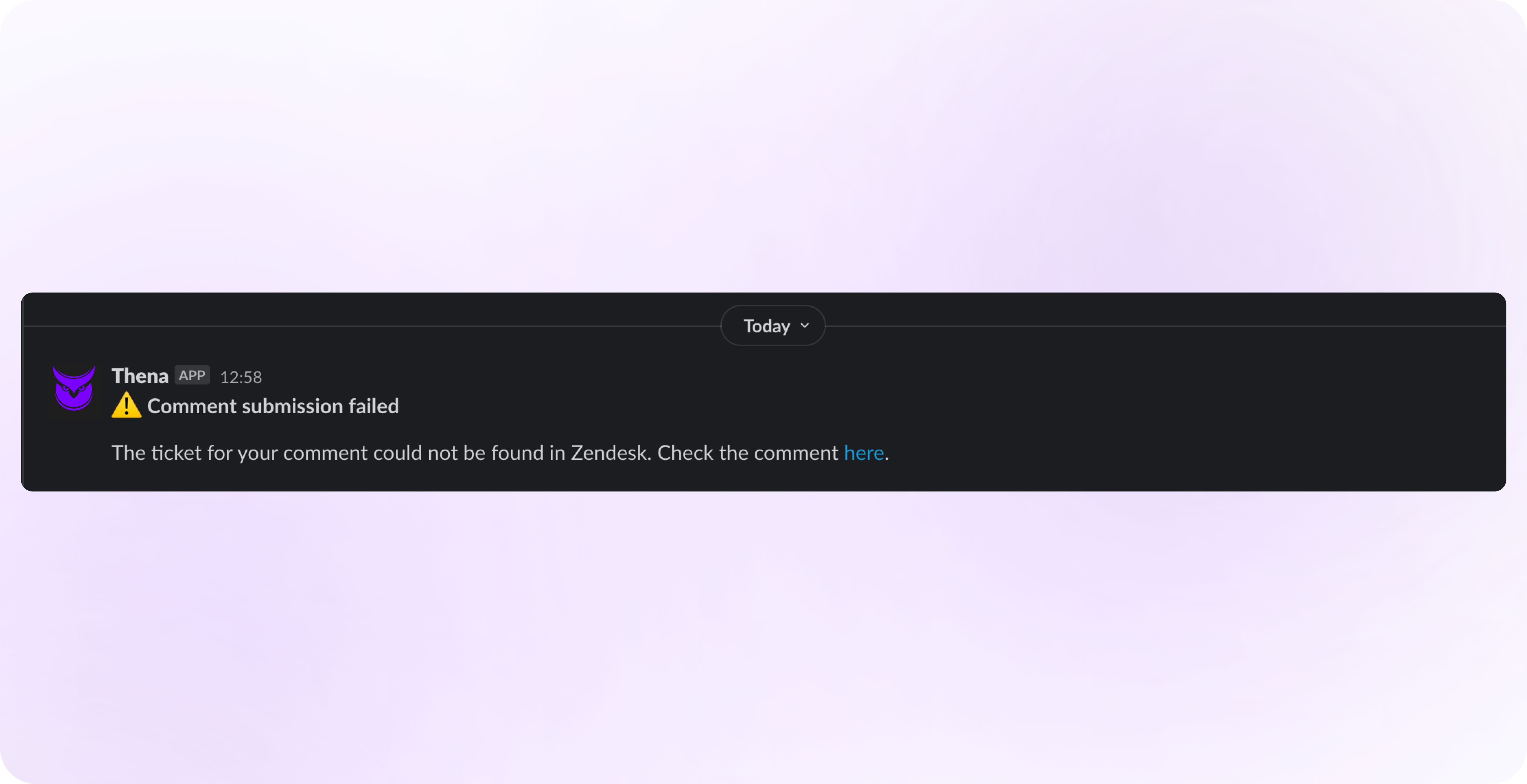
The relevant Slack permalink will be attached with each error message for your reference.
An exhaustive list of all the error messages, along with descriptions, is listed below :
| Error heading | Error description |
|---|---|
| Ticket creation failed | We couldn't create a ticket after 3 attempts due to Zendesk rate limits. |
| Ticket creation failed | We couldn't create a ticket due to a record validation error in Zendesk. |
| Ticket creation failed | We couldn't create a ticket after 3 attempts due to Zendesk server error. |
| Status update error | Failed to update the status after 3 retries due to Zendesk's rate limits. |
| Status update error | Status update failed due to a record validation error in Zendesk. |
| Status update error | The ticket you're trying to update doesn't exist in Zendesk. |
| Status update error | Failed to update the status after 3 retries due to Zendesk server error. |
| Comment submission failed | Failed to add a comment after 3 attempts due to Zendesk rate limits. |
| Comment submission failed | Failed to add a comment due to a record validation error in Zendesk. |
| Comment submission failed | The ticket for your comment could not be found in Zendesk. |
| Comment submission failed | Failed to add a comment after 3 attempts due to Zendesk server error. |
FAQs
How do I migrate from my current Zendesk Integration to the updated External Ticketing?
If you're looking to transition to our enhanced External Ticketing system, please contact your designated point of contact (PoC) at Thena. Our team is ready to facilitate a smooth migration process for you.
What Enhancements Can You Expect with the New External Ticketing System?
Upon transitioning to the new External Ticketing System, you'll benefit from a suite of improvements designed to enhance your workflow and broaden integration capabilities:
-
Multi-Account Linking
- Effortlessly link multiple Zendesk accounts to a single Slack workspace for a unified ticketing experience.
-
Custom Field Mapping
- Gain the flexibility to map Thena-specific fields, such as Slack channel and message permalink, to custom fields within Zendesk for improved data alignment.
-
Revamped UI for Zendesk Integration
- Experience a completely redesigned user interface for Zendesk integration and management within Thena, aimed at simplifying navigation and functionality.
-
Enhanced Ticket Management
- Implement mandatory fields for ticket creation and closure directly from Slack, ensuring all necessary information is captured from the start.
-
Real-Time Synchronization
- Benefit from real-time updates of tags and fields between Thena and Zendesk, keeping ticket information current and synchronized.
-
Improved Slack Modal for Form Creation
- The Slack modal for form creation has been updated to include:
- Dynamic Forms and Fields: Customize the ticket submission process to suit specific needs.
- Type-Ahead Search for Priority Selection: Move from radio buttons to a direct Zendesk query for priority selection, enhancing user experience.
- Simplified Ticket Creation Modal: Default Thena tags have been removed, and the message has been updated to guide users more effectively through the submission process.
- Previous Message: "Hi 👋 Dave. Tell us more."
- New Message: "Hi Dave. Please fill out the following information to provide our support team with full context regarding your issue. Submitting this form will generate a ticket in our support queue."
- The Slack modal for form creation has been updated to include:
-
Streamlined Ticket Details
- The request type (e.g., Tech Support, Account Management) has been removed from the ticket details message sent in the thread for a cleaner and more focused presentation.
-
Consolidated Webhook Configuration
In an effort to streamline integration and simplify management, the previous approach of creating two separate webhooks—one for comment updates and another for status changes—has been revised. Now, a single webhook is utilized to handle both comment and status updates, enhancing efficiency and reducing complexity in webhook management within Zendesk.
These updates reflect our commitment to delivering a seamless, efficient, and user-friendly ticketing experience through our integration with Zendesk.
What happens after I react with the ticket emoji on a message?
After you react with the ticket emoji, a form will appear where you need to fill in the necessary details to create a ticket in Zendesk. Once the form is submitted, the ticket is created in Zendesk.
Can I create a ticket without selecting a specific message in Slack?
Yes, you can create a ticket without referring to a specific message by using the "/create" command and selecting the "Create a Ticket" shortcut by Thena.
What should I do if the form for creating a ticket does not appear after initiating the process?
If the form does not appear, check your Advanced Configuration settings if either your auto create setting is switch on. If you add the ticket emoticon and even then there is no form on the pop up, enable the "Send a message in the thread to fill out the form for ticket creation in Slack when "🎫" emoticon is added" configuration setting.
How do I ensure that my created tickets are tracked in Zendesk?
After creating a ticket, it will automatically be added to Zendesk. You can track the status of your tickets directly in Zendesk or through any Zendesk integration in your Slack workspace.
How do I set up automatic field filling in Thena for Zendesk tickets?
To set up automatic field mapping from Thena to Zendesk, navigate to the Forms and Fields tab under 'View Integration' for Zendesk in your Thena web app. In order to autofill fields, you can map the fields that you have configured on Zendesk against fields provided by Thena. For instance, linking a Slack permalink or customer information, and define the sources for these values.
I have added new fields to the form, but the same is not reflecting on Thena Dashboard.
Under Integrations, click on View Integration for Zendesk. Under 'Set Up' select the relevant Zendesk helpdesk instance. Click on 'Edit Helpdek' and 'Resync'. It is mandatory to do this every time you make a change to the fields or forms on Zendesk.
I have updated the field permissions of my form in Zendesk, but the same is not reflecting on Thena Dashboard.
Under Integrations, click on View Integration for Zendesk. Under 'Set Up' select the relevant Zendesk helpdesk instance. Click on 'Edit Helpdek' and 'Resync'. It is mandatory to do this every time you make a change to the field permissions or forms on Zendesk.
Why are some of my customer requests showing up as requested by the Zendesk admin?
Each Slack workspace has the ability to choose whether or not to display a member's email address. If the workspace has set this to No one, then Slack does not provide the email address of your customers through its API (image below)
The email is critical for our Zendesk integration to work. This is because we sync contacts between Slack and Zendesk using the email object. If the email id is not provided by Slack, Thena will automatically assign it to the Zendesk admin that setup the Thena integration.
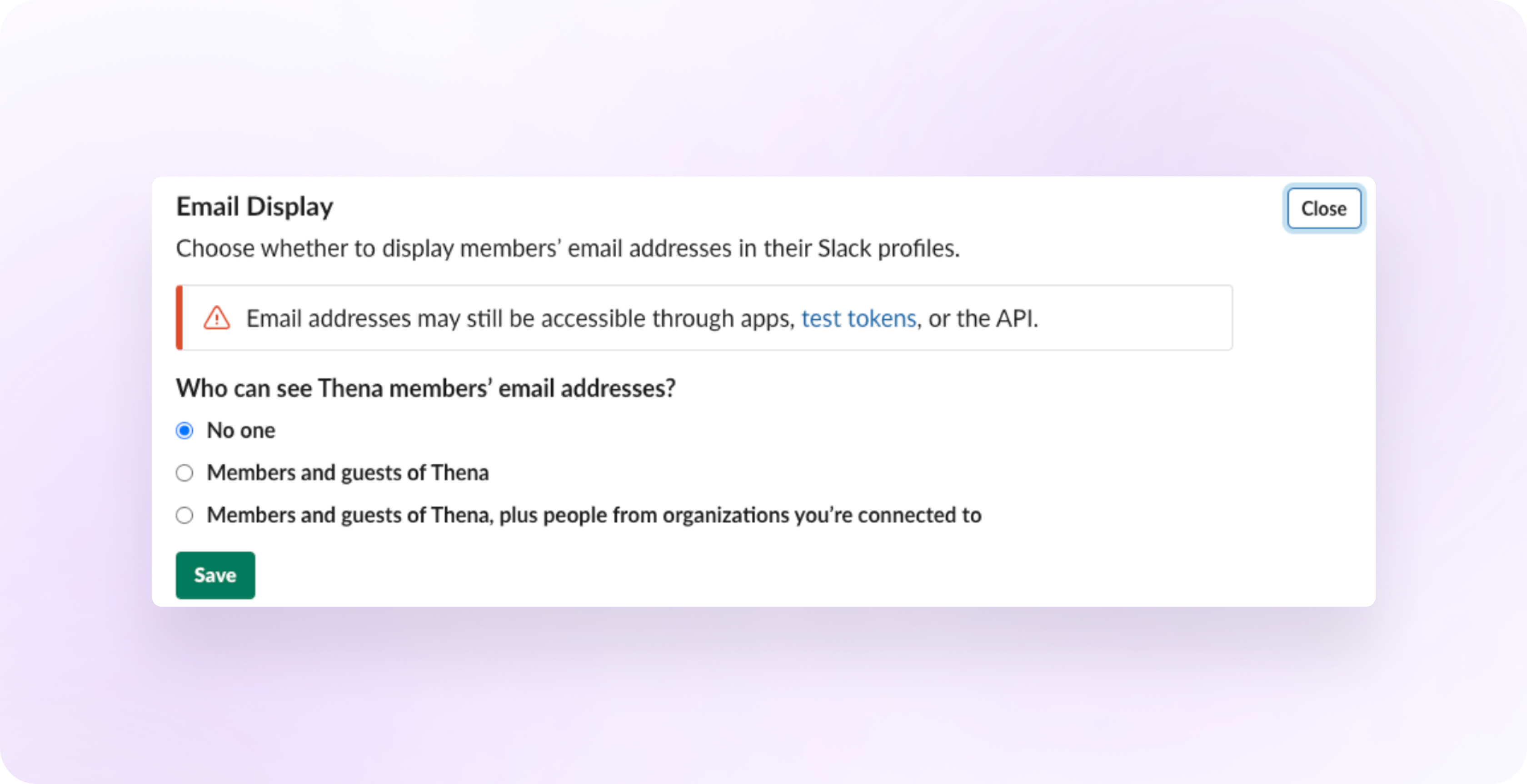
Why are responses by my agent from Zendesk showing up as they are sent as Thena on Slack?
Thena whitelabels the responses with the agent name and profile picture. If your agent's response is being delivered on Slack with the Thena icon and name, one of the following is the root cause:
- Agent user does NOT exist on Slack
- Agent has a different email on Slack vs that on Zendesk (case sensitive)
What is the new status of the ticket when I reopen it using a comment on the Slack thread?
The new ticket status moves to 'Open' and the same is updated on Slack and on Zendesk.
Why are my tickets not getting auto created even though the setting is enabled?
It may happen that the form you have configured on either the global level or for the specific channel, has mandatory fields for ticket creation. In this case, the auto creation would require a manual intervention from the user. The below Slack message will be posted :
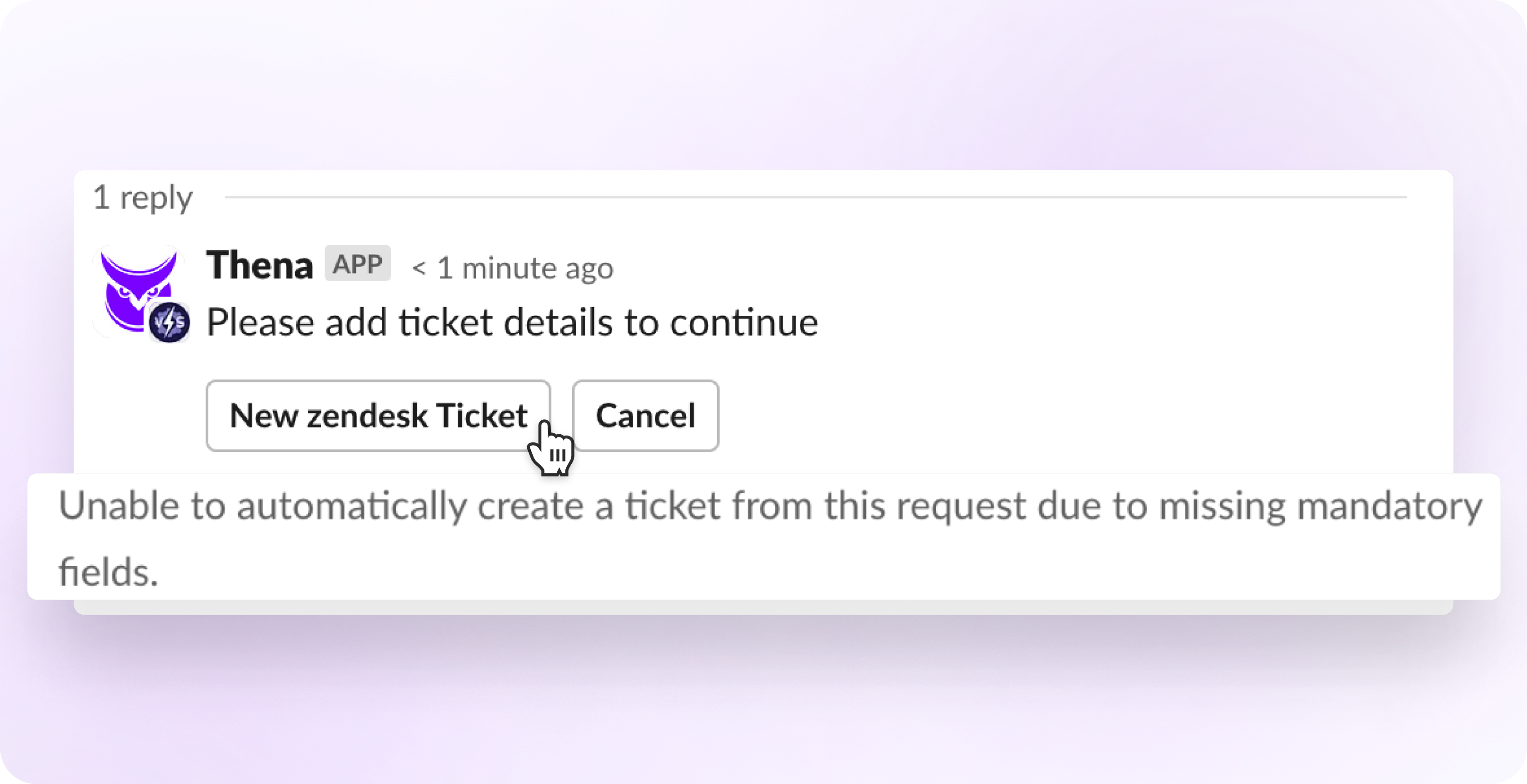
Please check your form configuration before enabling the "auto create" feature.
What happens if a ticket is raised on behalf of a user that does not exist on Zendesk?
In this scenario, Thena will automatically create a new user in Zendesk.
Why does the 'Requested By' dropdown show up when I am creating a ticket
In a private channel, we do not pull the user data to cater to privacy. That is why, you are asked to explicitly add the requestor in order to send it to Zendesk. This is then used to map and show the relevant user in Zendesk.
Does Priority sync work for the Zendesk integration?
Yes - We sync both Status and Priority bi-directionally from Slack <> Zendesk.
Should I create a new Admin user in Zendesk for the integration?
This is optional - You can continue to use an existing admin account, or create a new user.
What happens if I create the integration in Zendesk as an Agent (and not as an Admin)?
If the integration is setup as an agent, then the Zendesk API ends up passing a lot of customer messages as a message from the Zendesk Thena admin, instead of mapping the message correctly.
Why am I unable to receive hyperlinked text in Slack when I send a message through Zendesk?
This is due to the limitations with the Zendesk Webhooks which do not support complete HTML. As an alternative, you can share the exact link instead of hyper linking Eg: https://example.com/ instead of Example.
Am I able to track the ticketing volume from Thena/Slack in Zendesk?
Yes, you can enable what's known as a default tag to send to Zendesk. This can be something like thenaSlackRequest. All requests that originate from Slack will have the default tag applied. To request default tagging, please reach out to the Thena team.
Will Internal notes in Zendesk be visible on Slack?
No - Internal notes are viewed as collaboration within the Support team. As a result, we do not show the internal notes to the customer.
What happens if the user who's message is being converted into a ticket is suspended in Zendesk
When converting a Slack message to a Zendesk ticket, if the user who sent the original message in Slack is marked as suspended in Zendesk, we try to un-suspend the user in Zendesk and if Zendesk does not allow un-suspending the users, we fallback to create the ticket using the admin user who had integrated Thena with Zendesk.
Why did a reply from a fellow support agent become an internal note?
As per Zendesk's documentation below, this is an expected outcome. Refer Zendesk documentation for more info.

How do I disable emails for tickets created via Slack?
Please share the name of your tag with ThenaPlease go through the steps below on Zendesk and then share this tag with us and we will configure this tag to be sent with all of your tickets.
Go to Zendesk Admin panel --> Object and Rules --> Business Rules --> Triggers --> Notify
- Select Trigger - Notify requester and CCs of comment update
- Add a condition of tag contains non of the following: {{yourslacktag}}
What occurs when a Zendesk ticket is closed, and the customer replies to the Slack thread for a follow-up question?
When a Zendesk ticket is closed, and the customer responds in the Slack thread with a follow-up question, we create a new ticket in Zendesk as a follow-up to previous ticket. This process continues with subsequent follow-up tickets for ongoing communication.
Here is an example of how this process works:
Let's say theZendesk closure automation is set to two days.
A customer submits a request on Slack which initiates the creation of a Zendesk ticket (T1).
The support team resolves the issue and marks the ticket as Solved, which results in the ticket being closed due to the Zendesk automation.
After two days, the customer has a follow-up question and responds on the Slack thread. As T1 is closed, this triggers the automatic creation of a follow-up ticket (T2) in Zendesk, which is a follow up ticket to Ticket T1.
The vendor works on the follow-up ticket (T2) and marks it as solved in Zendesk, ultimately resulting in its closure due to Zendesk Automation.
If the customer responds again on the Slack thread after the closure of T2, it triggers the generation of another follow-up ticket (T3) in Zendesk. This new ticket (T3) serves as a follow-up to T2.
Note: Follow up ticket creation/ticket reopening will not be triggered on vendor responses on the thread
Can we close the Ticket using emoticons?
Zendesk tickets cannot be closed using emoticons.
What type of authentication does Thena use to authenticate into Zendesk?
Thena integrates with Zendesk using API token integration, rather than OAuth or basic authentication methods. This means you won't need to provide your username and password for the integration. Whether you're integrating a single Zendesk (ZD) instance or multiple ZD instances, our approach remains consistent. To set up the integration, you will need to log into your ZD instance using a service account and generate an API token with this account. For successful integration with Thena, we require the below three items : (Refer authentication steps)
- User email associated with the Zendesk account
- Zendesk URL
- Zendesk API token
It's important to note that you do not need to log into the Thena web application with this service account. This method ensures a secure and efficient integration process, aligning with Zendesk's documentation, which advises against using basic authentication if your organization uses Single Sign-On (SSO) or two-factor authentication.
Can I integrate with Thena if I use SSO for Zendesk?
Yes, you can still integrate with Thena even if your organization uses Single Sign-On (SSO) or two-factor authentication in your Zendesk user profile. Since Thena utilizes API token integration to connect with Zendesk, the use of SSO or two-factor authentication does not hinder the integration process. You will need to log into your Zendesk instance using a service account specifically to generate the required API token. This approach aligns with Zendesk's recommendation to use an API token or another OAuth access token instead of basic authentication under such security settings. For integration, you will need to provide the user email, Zendesk URL, and the generated API token. This ensures a secure and seamless integration without compromising your organization's authentication protocols.
I can see the fields in my Zendesk form but those are not available in the form in Slack, how can I keep same forms on Zendesk and Slack?
Not all fields in Zendesk forms are accessible and editable when they appear in Slack. This discrepancy occurs because only fields that are editable by the end user in Zendesk are carried over to the Slack form. If a field is mandatory for creating a request in Zendesk, it will automatically be included in the Slack form to ensure consistency in the request creation process. To manage and understand which fields will appear in your Slack form, you should review the field permissions in Zendesk.
For more details on managing field permissions in Zendesk, refer to the Zendesk field permissions documentation.
Are conditional forms on Zendesk supported in Slack with Thena?
Currently, the conditional logic used in Zendesk forms does not directly translate to Slack when using Thena. However, support for conditional forms in Slack via Thena is under development and expected to be released soon. This means that in the near future, you will be able to create more dynamic and context-sensitive forms in Slack that behave similarly to their Zendesk counterparts. Stay tuned for updates on the availability of this feature.
Updated 5 months ago
